The Breakdown
Pros
Cons
I’ve Fallen Prey To A Bell SRT Modular Predator
First Impression & Fitment
I’ve just finished reviewing 3 successive helmets that all (to varying degrees) hurt my head to wear. All of them were shaped too narrow for my Round Oval skull.
Thankfully relief came in the form of this Bell SRT Modular lid that fits perfectly. I actually let out an audible sigh when it first settled on my head and didn’t produce any friction, hot spots, or pinch points.
Ahhhhh… I sound like Goldilocks must have when settling into Baby Bear’s bed.
Thank You!
Many thanks to Bell Helmets and 2Wheel for supplying us with this helmet at no charge to torture test in the name of helping riders in need make an informed buying choice.
Shopping Now? We Recommend:
webBikeWorld works closely with RevZilla and Amazon to provide our testers with quality products to review. While we have an affiliate relationship and receive a commission from items purchased, this addition comes at no additional cost to you. It is the primary way we pay for our site and reviewers.
Also Available on Amazon
Sizing
I’ve got my hands on a size Large that fits a bit small. My 23 inch (58.45cm) head always seems to fall between the Medium and Large area on every helmet manufacturer sizing chart.
Typically I go for the smaller Medium in order to avoid a loose fit. In the case of the SRT Modular, there’s an overlap right at 22.8 inches and true to form I think either the Medium or Large would have fit me just fine.
After spending about 500 miles wearing it I’ve noticed the cheek padding has relaxed slightly and the helmet is just on the verge of feeling a tiny bit loose, but still fits. I think in future Bell Helmet reviews I’ll opt for the Medium instead and see how it differs.
Photo by Gerry Cote
The photo above features my friend Gerry wearing the SRT Modular and you can see how it squishes his cheeks a lot more than it does mine (see the photo below of me wearing it). Gerry legitimately has a 24 inch (60cm) sized head and is therefore always a size Large helmet buyer.
Photo by Jonathan Rundle
My First Bell Review
This is the first offering from the legendary Bell Helmets USA factory to grace my melon and I’m quite curious about how it will feel and perform over time. Bell is well known and respected as a helmet innovator today and ever since 1954 when Roy Richter founded the company.
Their familiar white oval Bell logo affixed on the front of the SRT Modular with vermilion lettering catches my eye first and I have high expectations for this helmet right out of the gate bearing the history of this American brand in mind.
A Little Late Maybe?
We’re a bit late to the table so to speak with this review being that the SRT Modular first dropped in the Spring of 2018 but hey better late than never, right?
Design & Build Quality
Design Aspects
I’m testing the “Predator Gloss White-Black” graphics version of the SRT Modular which is very sharp looking to my eye. I think it helps with visibility having this vaguely white tiger type of pattern gracing my head. Style and practicality… excellent!
Photo courtesy of Bell Helmets USA
This is the modular version (flip up chin bar style) of the popular sport touring full face Bell SRT helmet pictured above. They look very similar, but there are a few differences between the two apart from the obvious flip up chin bar on the modular:
- The SRT has a third vent over top of the visor below the Bell logo which is absent on the SRT Modular
- The SRT lacks the internal sun visor the SRT Modular comes with
- The $349.99 SRT Modular costs almost double the $199.99 SRT
- The SRT has SNELL M2015 certification while the Modular is DOT only
DOT Only Rating
The big question in my mind is: Does adding an internal sun visor lens to the SRT Modular along with a hinged chin bar really disqualify it from receiving the SNELL M2015 safety rating given to the very similar SRT?
You may point to the hollow void in the EPS foam needed to house the retractable sun visor in the SRT Modular shell creating an area more prone to failure in a crash as the reason. You’d be correct as far as I can see in SNELL’s refusal to certify helmets with this attractive feature in them.
That does seem to be the pattern amongst almost any modular versions of SNELL approved full-face helmets on the market I’ve seen. Case in point, the Simpson Bandit vs Simpson Mod Bandit.
Does the SRT’s third air vent really make it that much stronger than the Modular version? There’s still channeling in the same area in the SRT to allow air flow inside which would also create a void (albeit a smaller one) in the EPS foam and conceivably a weak point as well, right?
In my opinion, the SRT Modular should be very close to “SNELL worthy” when it comes to crash protection despite the fact it lacks the sticker on the back. I would like to see some actual SNELL testing results from helmets with integrated sun visors to know for sure what the difference is… but I digress.
Two Shell Sizes
The SRT full face helmet is available in three shell sizes while this SRT Modular only gets two for some reason. That means XS right up to Large sized SRT Modular helmets will all use the same shell and you may find yourself hearing from a certain fictional Scottish movie character that your “head has its own weather system” or “looks like an orange on a toothpick” if you wear a Small or XS size.
Fiberglass Composite Shell
This SRT Modular is slightly stronger and heavier than the average helmet. The lightweight fiberglass-composite materials used to build the shell should make it lighter than average, but It isn’t.
I think Bell purposely added bulk to the SRT shell this Modular hails from in order to ensure it passed the SNELL standards testing. That extra weight seems to have carried over into this Modular design without getting the benefit of SNELL approval.
RevZilla lists it as weighing 3.89lbs which is, in fact, lighter than the 4lb 2oz Shoei Neotec 2. I weighed this SRT Modular on my own scale and plotted it right at 4lbs. It feels basically the same weight as the Neotec 2 does in my hands.
With a Lexin FT4 BlueTooth communicator (link to review coming soon) installed it only gained 2 more oz ending up identical in weight with the Neotec 2 without its SENA SRL system installed.
Are you surprised to hear that? Don’t be as the Neotec 2 has been criticized for being overweight. The Schuberth C4 isn’t really any slimmer FYI. Modulars are typically heavier than full face helmets, but there are plenty of them out there significantly lighter than the Neotec 2, C4 and this SRT Modular.
Out on the road, I’m not bothered by the weight of the SRT Modular one bit much to my surprise, despite the fact I favor wearing helmets closer to the 3lb mark as a general rule.
Shopping Now? We Recommend:
webBikeWorld works closely with RevZilla and Amazon to provide our testers with quality products to review. While we have an affiliate relationship and receive a commission from items purchased, this addition comes at no additional cost to you. It is the primary way we pay for our site and reviewers.
Also Available on Amazon
Simple Yet Stylish
I’m not seriously going to compare this Bell SRT Modular to the Shoei Neotec 2 because they really aren’t in the same class. The Neotec 2 is a better overall helmet, but as you’ll find out it’s not a TON better in my esteem.
Having said that, I do see similarities between the two despite the huge difference in price points. The Neotec 2 is justifiably billed as one of the best modular helmets on the market right now (read a review of it here), so any common ground the Bell might have with it is a noteworthy feather in the SRT Modular’s cap.
One aspect is how both helmets have a fairly muted shell design when it comes to aerodynamic cutouts, divots, and fins used to calm turbulent air in the name of quieting the ride experience. The SRT Modular is generally smooth-shelled with some very minor indentations found on the sides of the crown area and chin bar along with a minor spoiler in the back.
These lines are twice as prominent on the Neotec 2 which was extensively wind tunnel tested during development.
Hi Viz Patches
A good safety feature is the twin reflective patches on the bottom of the helmet cheek pads. They light up nicely when viewed from behind while out on the road.
Wind Noise On The Road
I would have to say that Bell might have been wiser to go more aggressive with the “scoops and swoops” built into the shell because the SRT Modular isn’t an especially quiet helmet, relative to others on the market. Interestingly I don’t find the Neotec 2 super quiet either although some other testers feel differently about it.
This SRT Modular isn’t ridiculously loud though. It’s consistently noisy whether I’m tucked in behind my windshield or right out in the wind blast without any wind protection. I describe the noise level as mid-volume, low-frequency booming roar combined with the typical hissing found even in the quietest helmets I’ve tested.
It’s tolerable even without wearing earplugs. I don’t have any trouble hearing music or phone calls at legal speeds coming through on the Lexin FT4 Bluetooth communicator speakers.
The Chin Curtain Is Too Small
Some of the blame for this helmet being on the loud side can be attributed to the chin curtain design. It’s just too small and allows air to rush up into the chin bar area creating a flap. The smaller size makes putting the helmet on or taking it off easier, but the design misses the mark and should be improved.
Chinstrap
The SRT Modular comes with a traditional double D ring style chinstrap that is simple and effective at fastening the helmet on your head.
There’s enough superfluous chinstrap left over after I cinch it through the D rings for me to fasten the snap closed on the end and fold the leftover loop up into the opposite side cheek pad. This is just enough to avoid having it flap around in the wind on my face, but on someone with a larger chin it might not work out as well.
I bet Jay Leno probably doesn’t wear an SRT Modular helmet…
Lift & Pull
This helmet does have quite a long “nose” on it partly because of its modular design. The good side of that is there’s plenty of room to have a boom-style microphone in front of your mouth and if you have a big nose yourself it won’t get bashed when you raise or lower the chin bar.
The downside is felt whenever riding in a crosswind because the extra length acts as a lever for the wind to work on. I found noticeable pull issues while riding in crosswind with the SRT Modular, unfortunately, but no lift concerns on the bright side.
Dual Homologated Design?
Bell doesn’t specifically say they designed this lid to be worn with the chin bar raised while riding, but they don’t say you can’t do it either.
I always lift my chin bar at red lights and leave it open until I get above somewhere around 40 mph. This helmet works very nicely in that regard and is quieter with the chin bar raised.
There’s a grey locking tab for the chin bar located on the left side right under the visor hinge. Lowering it locks the chin bar in the raised position, but I don’t really understand the need for these options, to be honest. I’ve never had a modular chin bar drop from the fully raised position in my testing of any helmet.
Panovision Class 1 Visor Design
The large tab used for lifting the visor could also be creating turbulence, noise, and vibration through the shell adding to the problem. It sticks out about ¾ of an inch from the front of the chin bar and I would have to think must be creating some degree of noise.
To its credit the central location on the visor makes for an ambidextrous opening which is “handy” indeed.
Photo by Jonathan Rundle
Optical Clarity
The unique design of the Panovision visor is borrowed from the high-end racing helmets in the Star lineup from Bell. It has a lower and longer cutout close to the hinge area on either side to allow easier shoulder checks and better peripheral views.
Indeed I found everything about the visor system to be clear and easy to like. The field of view was just what I’d like it to be and I didn’t notice any inclusions or faults in the visor plastic.
Fogging
This visor has an anti-fog coating on the inside that seemed to work for me, although I didn’t ride with it in very low temperatures or extremely humid ones. I did try purposely exhaling dramatically on it with the visor completely closed to see if I could fog it up, but the visor didn’t give in and remained clear.
I’d still prefer having a PinLock lens in it, but admit the coating seems to be good enough and helps keep the price lower.
Shopping Now? We Recommend:
webBikeWorld works closely with RevZilla and Amazon to provide our testers with quality products to review. While we have an affiliate relationship and receive a commission from items purchased, this addition comes at no additional cost to you. It is the primary way we pay for our site and reviewers.
Also Available on Amazon
Visor Positions/Detents
This visor is unusual in that it lacks multiple locked positions typically found on helmet visors I’ve reviewed up to now. It really only has three locked in points other than the fully closed one. The first locked in point comes when the visor is opened about 1 inch up.
Photo by Jonathan Rundle
Normally I would have a problem with that because a big pet peeve of mine is a visor that won’t stay barely cracked open with the air pushing against it at highway speeds. Bell did a terrific job designing this Panovision lens in a way that you can just open it ⅛ of an inch and leave it resting there solidly to get more air inside. It’ll stay there even with 80 mph wind force working on it.
Additionally, I found it reasonably solid even outside the locked in points on the hinge to my surprise. There’s enough resistance there to freeze it for the most part at legal speeds.
On And Off
The visor, in theory, is simple to remove or install. Just push in the inner button on each side to unlock the mechanism, then slide it forward while opening the visor to pop it off. Installation is the reverse.
The reality for me is that I have to hold my tongue just right while repeatedly pushing and holding in the buttons on each side while working the visor open and forward to finally get it to release.
Going back on is a bit easier, but I find it doesn’t want to lock into place easily even with the hinge fully seated in the receptacle. It’s not the worst visor attachment system I’ve encountered, but it could be better.
Integrated Sun Visor Lens
This is my favorite feature on the SRT Modular by far and probably why SNELL frustrates me by blackballing helmets equipped with it.
The switch on the lower left side used for controlling the sun lens position would be better located off the lip of the helmet to better accommodate clamp on style Bluetooth communicators like the Lexin I put on this one. Having said that moving the Lexin behind the slider switch hasn’t created any undue issues for me.
Nice Design Bell
The tint is just right on the sun lens for mitigating glare and so is the smooth action on the cable used to manipulate its position. It lowers just the right amount without touching my nose or leaving too large of a gap to let in irritating sunlight.
It’s interesting to note the outward curling lip Bell designed into the bottom of the sun visor lens. I can’t quite figure out what it’s for but I think it helps deflect incoming air/bugs/etc if you’re riding with the main visor raised and only the inner sun lens blocking your vulnerable eyes.
It’s really a satisfying design that works as I demand it should. Bravo Bell!
Airflow Issues
It’s a good thing the main visor can remain slightly ajar while riding to allow in refreshing air because the vents don’t do it to my satisfaction on the SRT Modular.
It’s puzzling to me that I can’t get enough wind to my face or the crown of my head because the vent apertures are straightforward to use even with gloves on and the openings seem a decent size. I do notice airflow even with the vents fully closed, but it’s not a lot different with them open.
I often found myself opening the visor even at 20 Celsius (68 F) temperatures to get relief. There are only two exhaust ports on the rear of the helmet and that may be the issue here even though they’re wide open vents.
If you look into the helmet it’s easy to see daylight shining through the mesh wire of these rear exhaust vents. How can it be so restricted for air flow?
The SRT Modular Isn’t Alone
This is another trait the SRT Modular shares with the Shoei Neotec 2 in my opinion. I didn’t find the airflow satisfactory with it either when compared to other modulars that do it justice like the AGV Sportmodular Carbon, Nolan N100-5, Simpson Mod Bandit or the GMax MD01.
Bell needs to address this on future SRT Modular helmets. If they are successful it will score higher when it comes to rider comfort in hot weather. I can only imagine what this would feel like in brutal 100-degree temps!
Poor Quality Air Vent Construction
Perhaps the problem can be linked to the physical construction of the air intakes?
The two sliding plastic switches used for operating the air vents smack of low quality plastic compared to many other helmets I’ve reviewed. I’m not a fan of how they have a rough feeling action that stutters and grinds slightly when moved forward or backward. You can see and hear the friction when running them. They also lack discernable locking points when fully open or closed.
I’ve seen other helmets with this style of vent switches wear out quickly and grow completely loose with regular use to the point they won’t stay fully closed after a while. It really grinds my gears, gets my goat, and just plain pisses me off. I’d rather pay $20 more for the helmet to get some quality switches installed from the factory.
Please fix this on future helmets, Bell!
Interior Design
Padding & Liner
The nylon mesh and microsuede covered interior padding in this helmet are soft, smooth, and comfortable to have rubbed against your face, neck, and crown. Bell chose very good quality material that wicks away sweat adequately in my experience riding in temperatures as high as 20 Celsius (68 F).
I did find one strand of thread had come loose on the chin curtain area and was sticking out weirdly, but it didn’t progress or cause damage over the 500 miles I rode while testing this lid.
It’s also washable and designed in a way that won’t easily grow microbial colonies in your headspace, thankfully.
Installing
Installing that Lexin FT4 was very easy thanks to the simple to remove and install cheek pads and crown liner. Bell also built large cutouts in the EPS foam in the perfect place to install the speakers for the Lexin system. The large cutouts leave room to make adjustments to where the speakers are located to better line up with the wearer’s ears.
No one will have any great difficulty installing Sena or Cardo systems in the SRT Modular either.
Nice job, Bell!
Final Verdict?
Photo by Gerry Cote
As I already mentioned this is a good choice of helmet for anyone looking to spend under $400.
It has nice features, excellent protective qualities, and a great appearance. Despite some criticism I have for it I think you’d be hard pressed to find anything much better for $349.99 in a modular helmet.
Competitors like the Nolan N100-5 and Simpson Mod Bandit both cost about $100 more and really aren’t $100 better in my opinion, as good as they are. The Nolan really is close though and I would likely make it my choice over this Bell if I could afford to pay more while shopping for a mid-level modular.
If you live in a hot climate and really need extra cooling airflow or have a narrow shaped head you may need to reconsider owning this helmet.
Pros
- Fiberglass composite shell
- Good value for money
- Racing helmet features borrowed from the Bell Star line
- Uncluttered design
- Internal sun visor
- Nice variety of graphics
- Fairly easy visor removal & installation
- Snell quality without the rating
Cons
- Fairly heavy
- Limited airflow
- Could be quieter
- Not PinLock ready
- Only 2 shell sizes
- Air vent design isn’t high quality
Specs
- Manufacturer: Bell Helmets USA
- Price (When Tested): $349.99 USD
- Made In: China
- Sizes: XS-XXXL
- Alternative colors: 10 colors/graphics packages
- Review Date: June 18, 2019
Shopping Now? We Recommend:
webBikeWorld works closely with RevZilla and Amazon to provide our testers with quality products to review. While we have an affiliate relationship and receive a commission from items purchased, this addition comes at no additional cost to you. It is the primary way we pay for our site and reviewers.
Also Available on Amazon

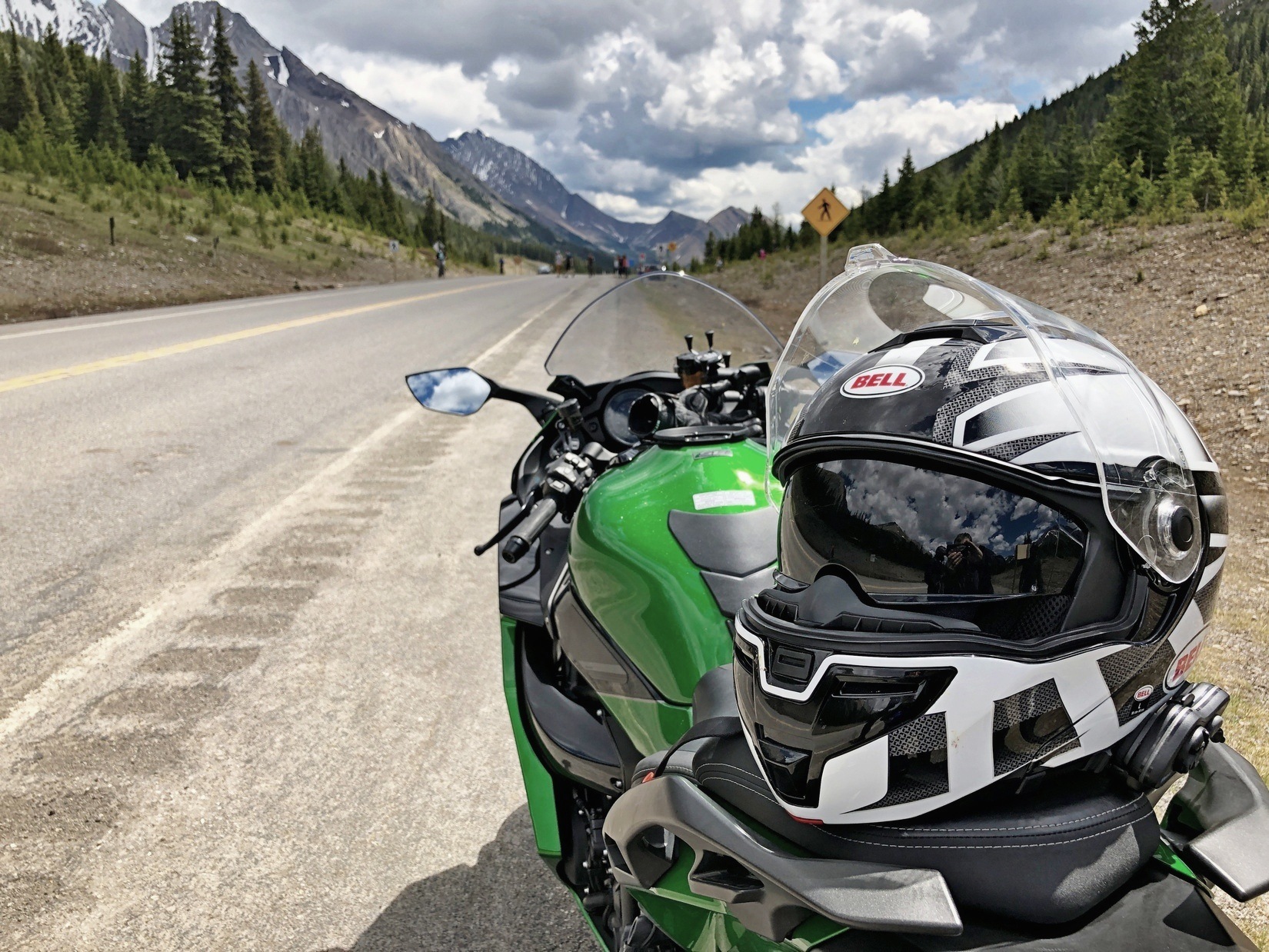

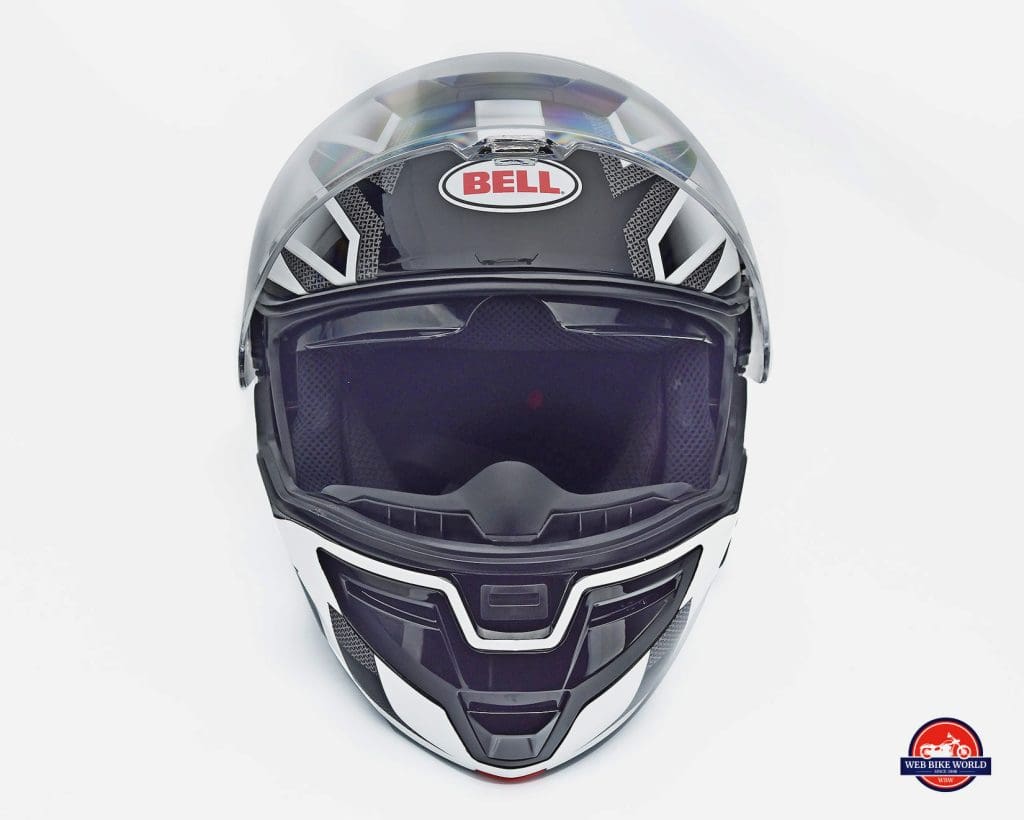

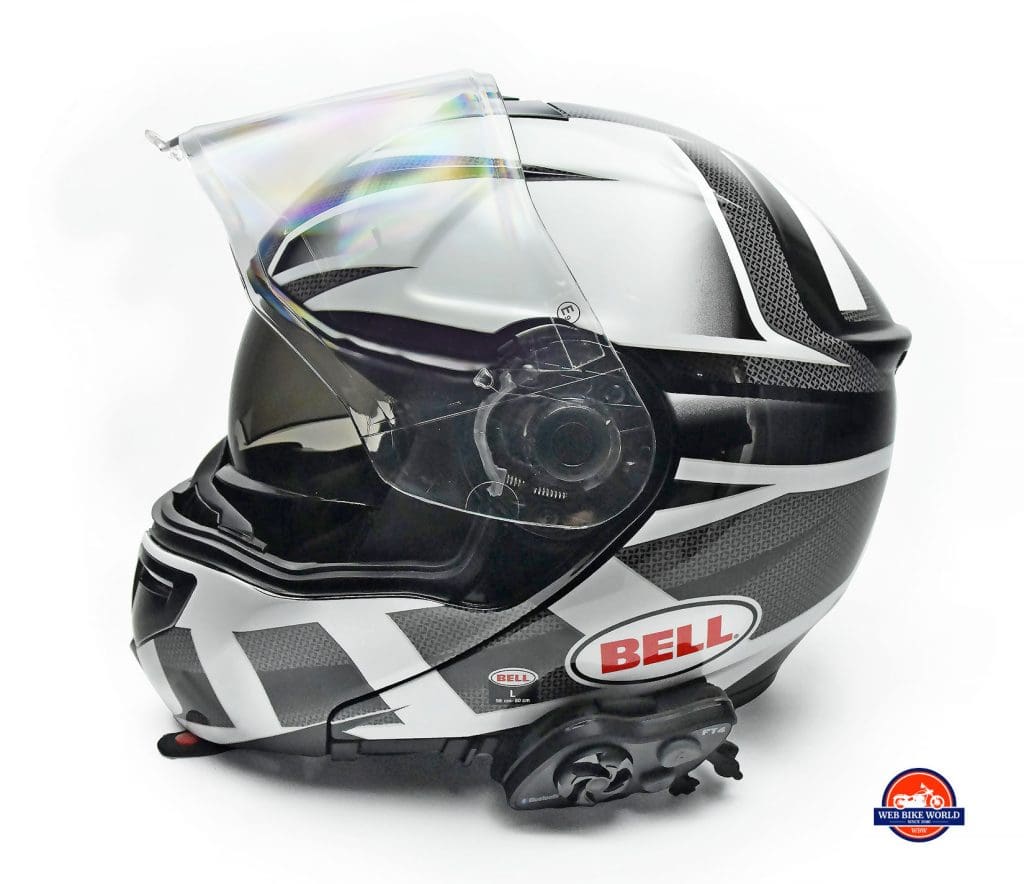
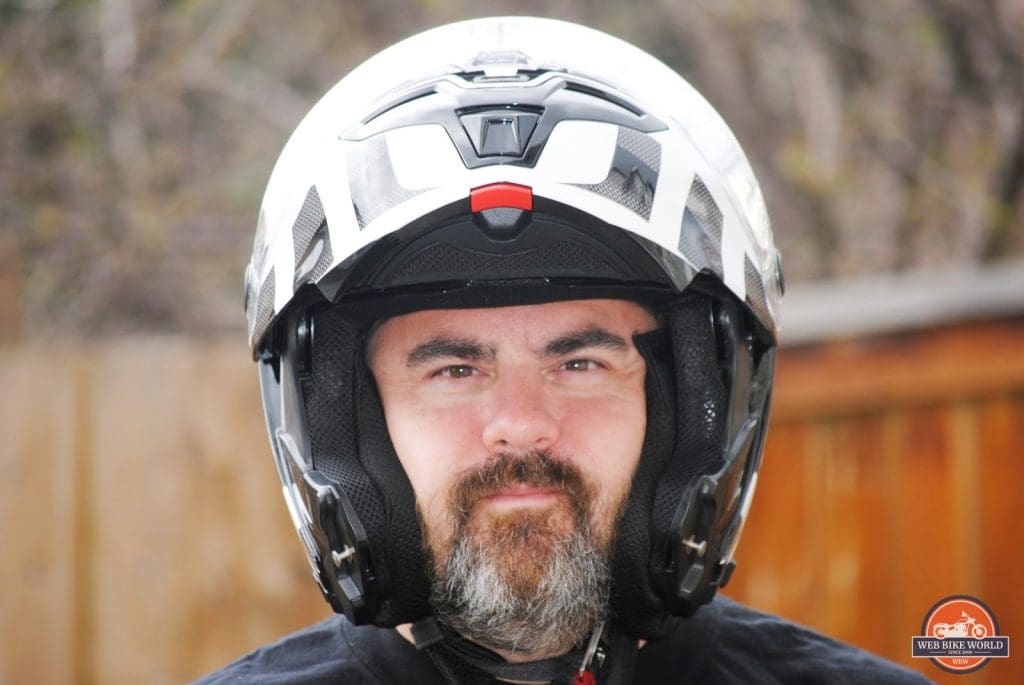
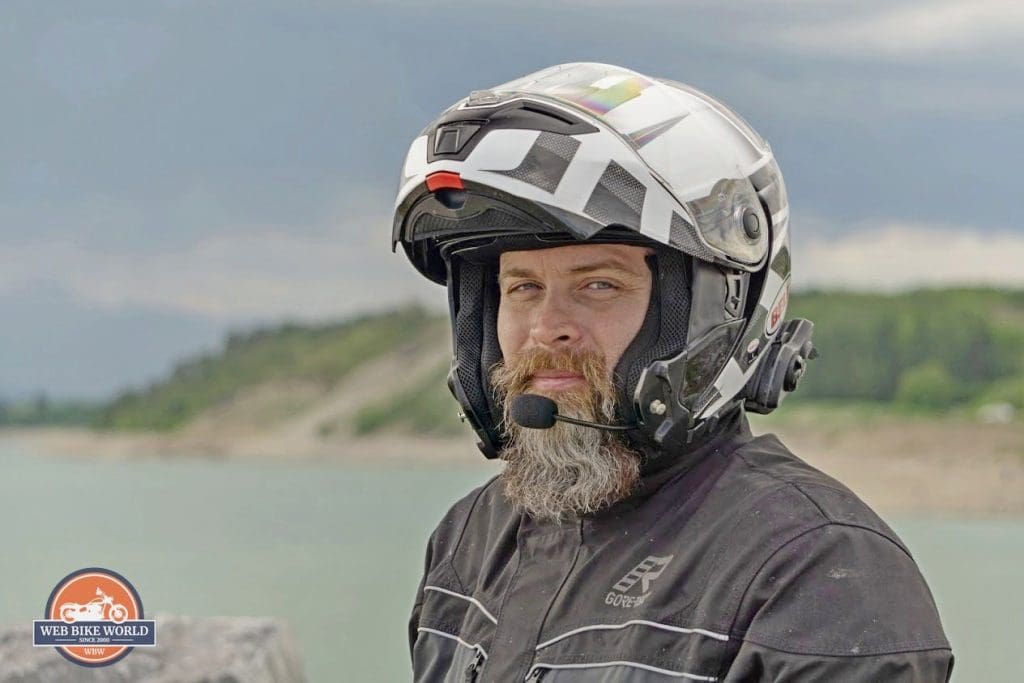
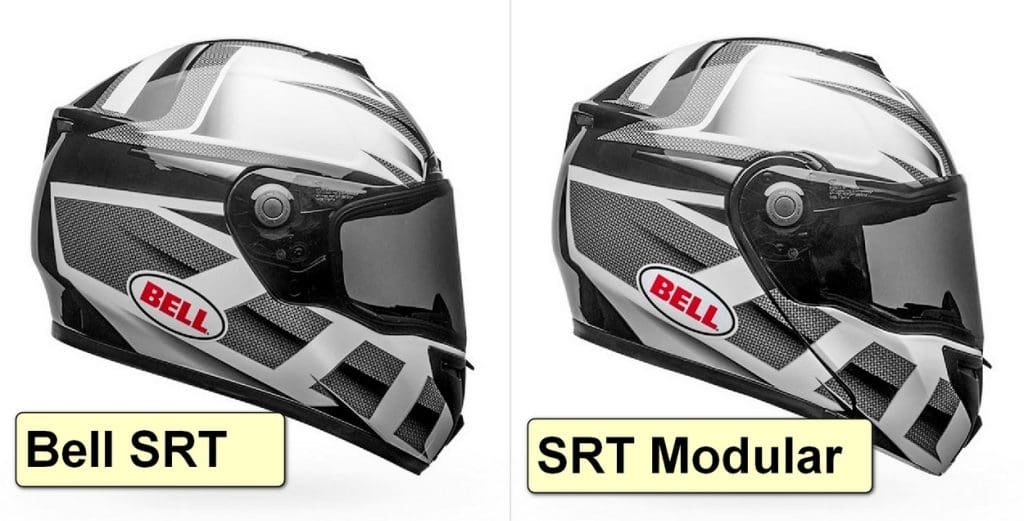
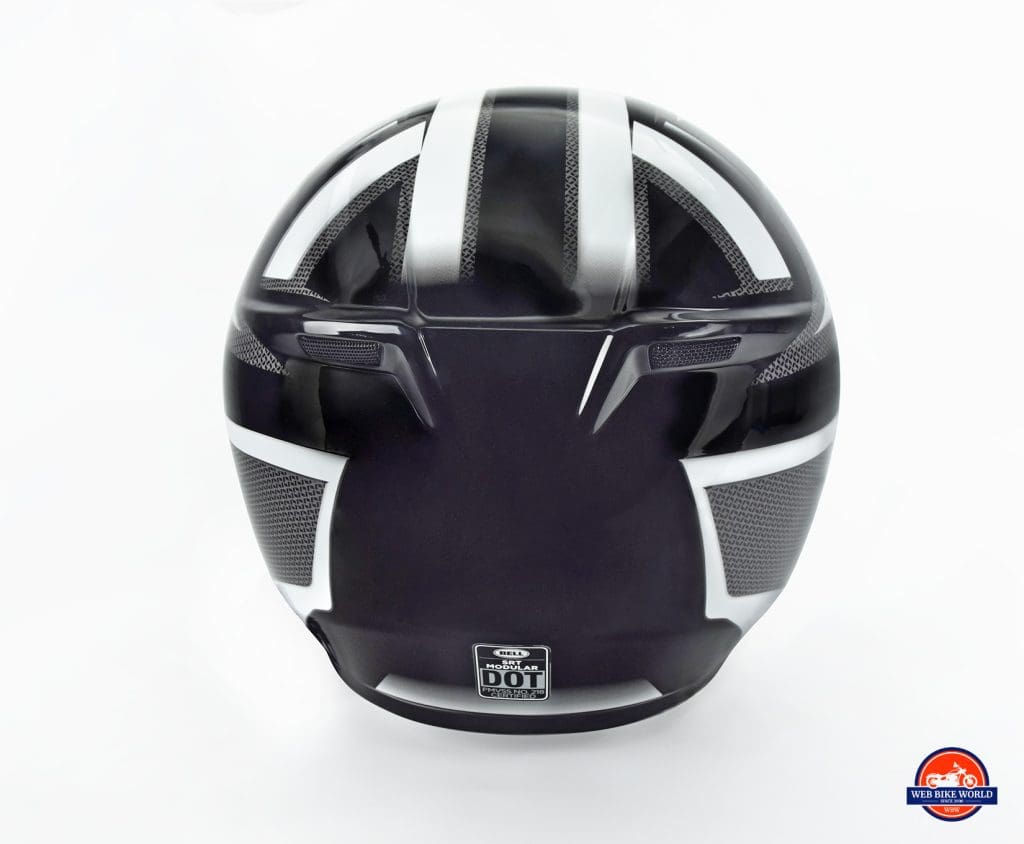
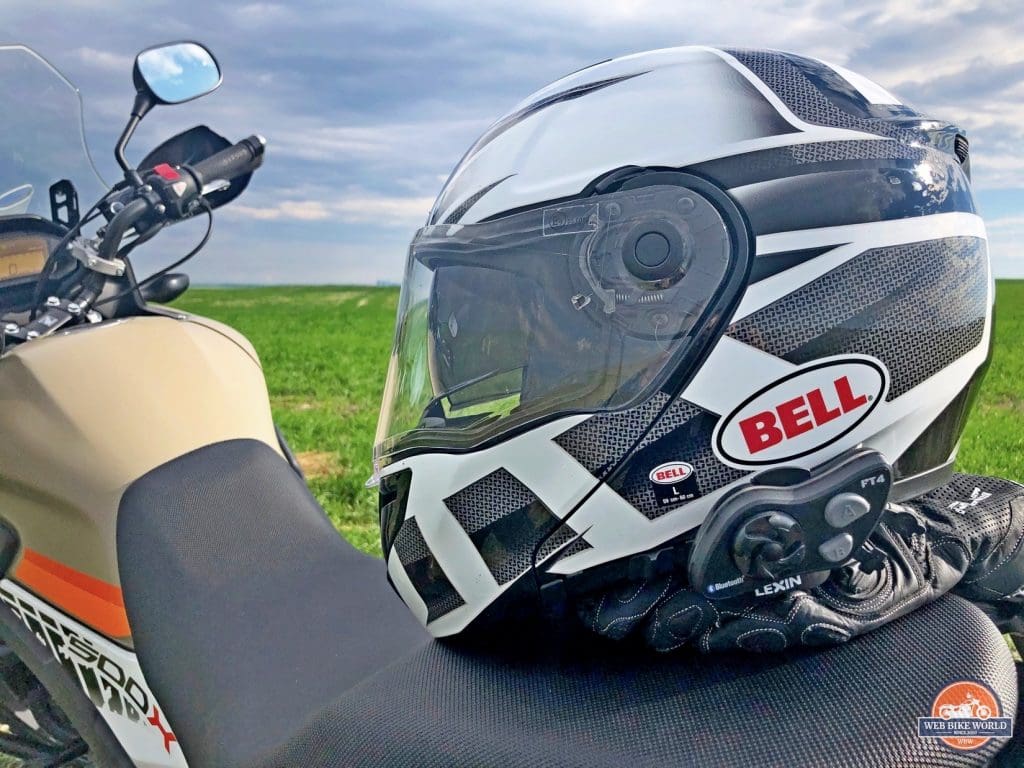
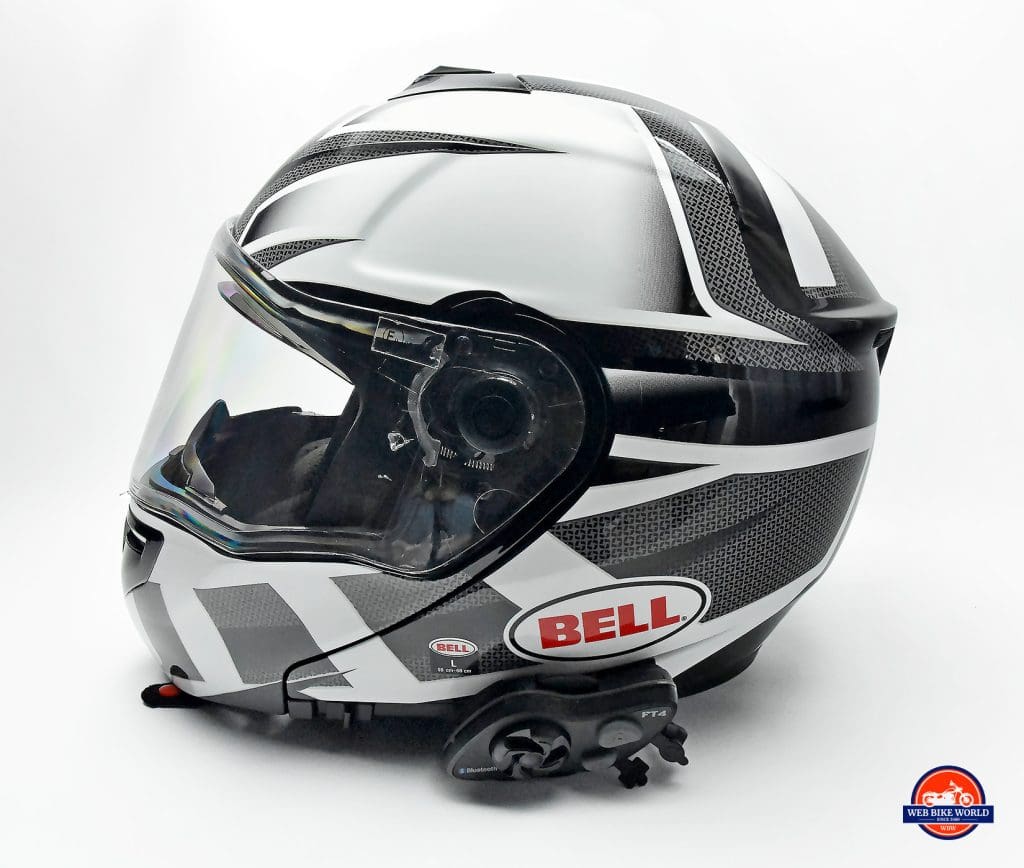
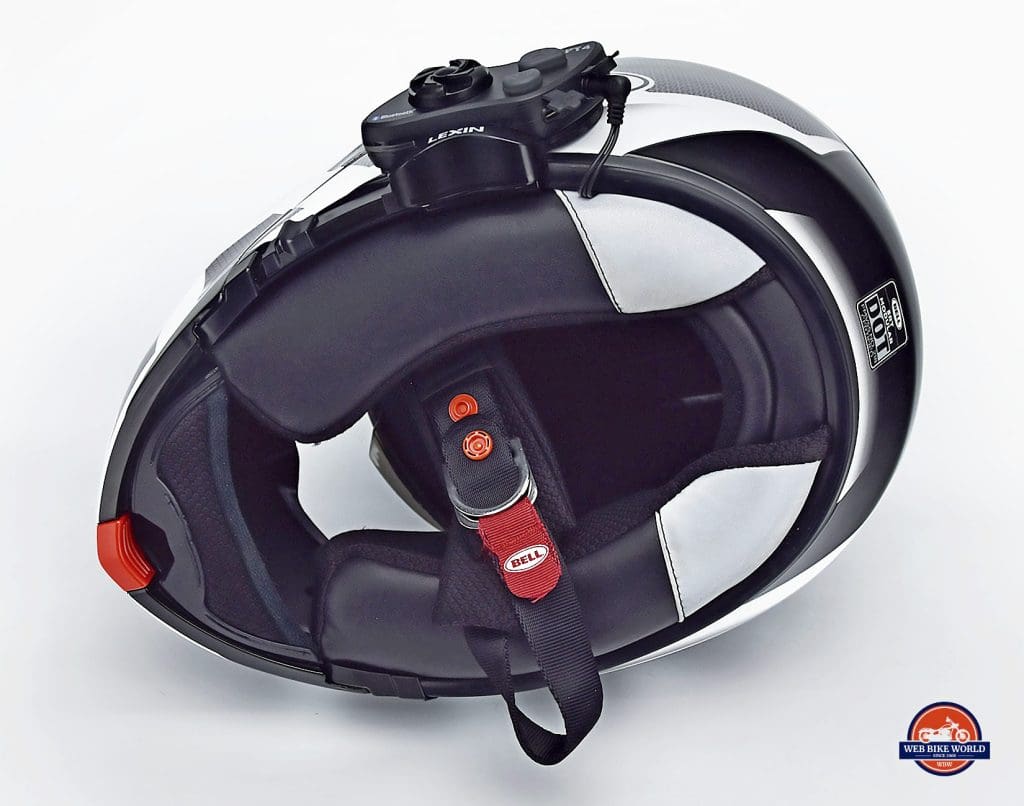
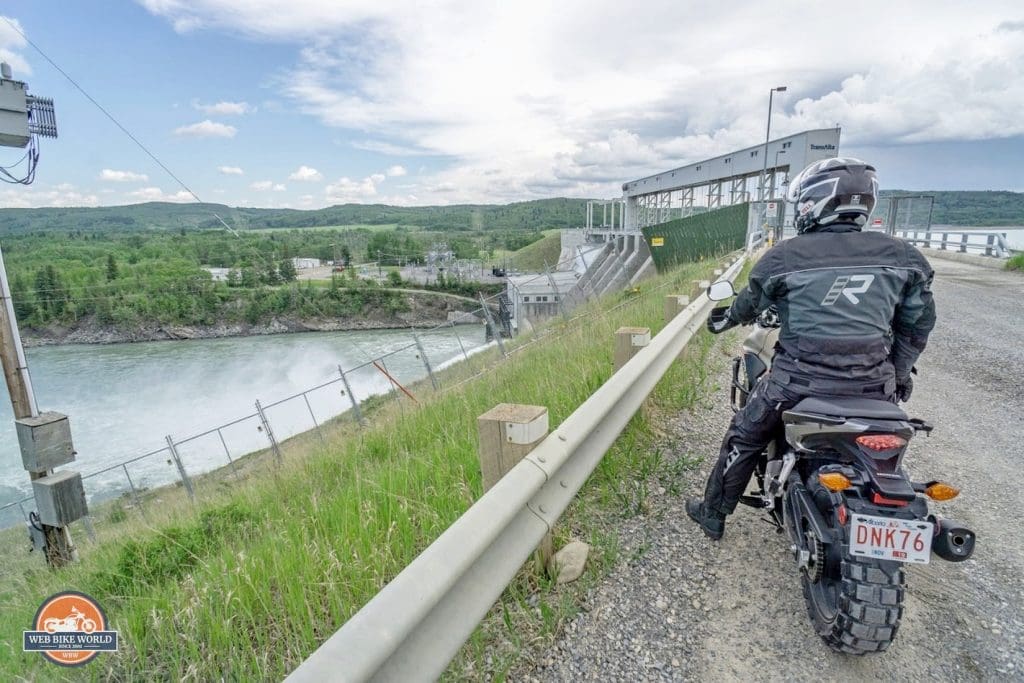
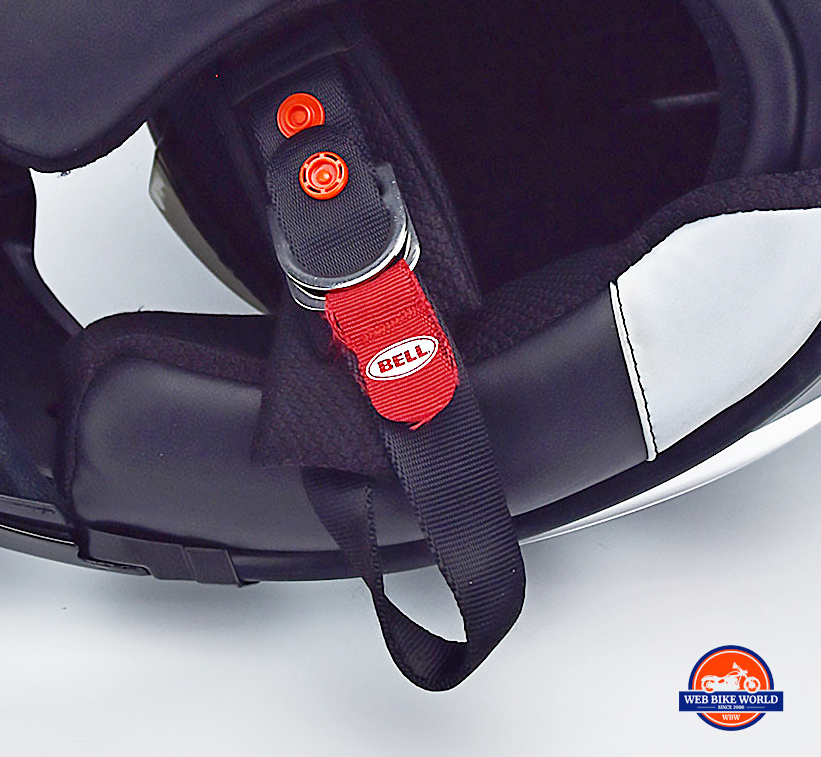
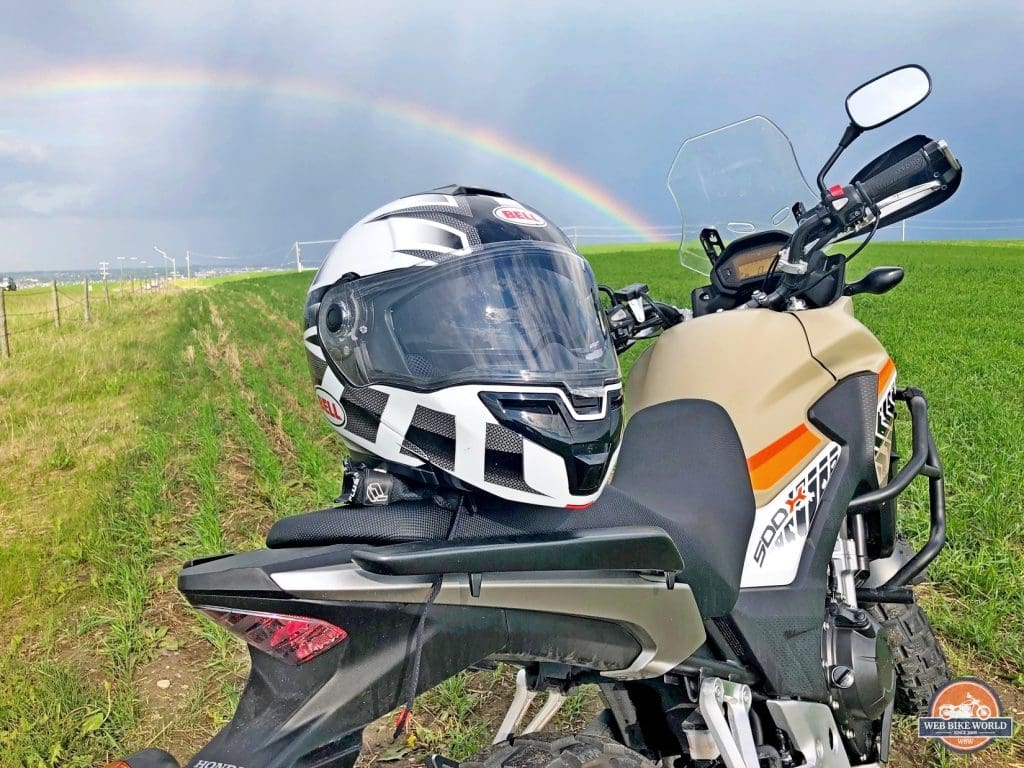
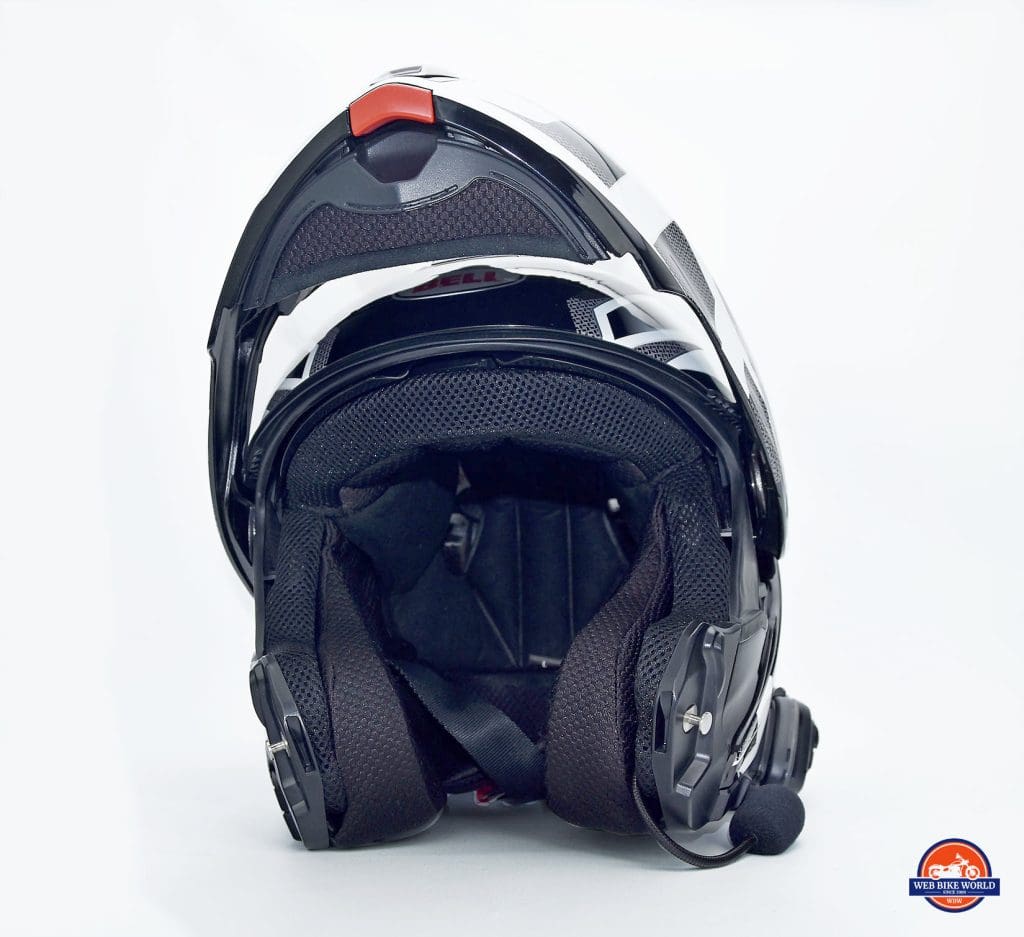
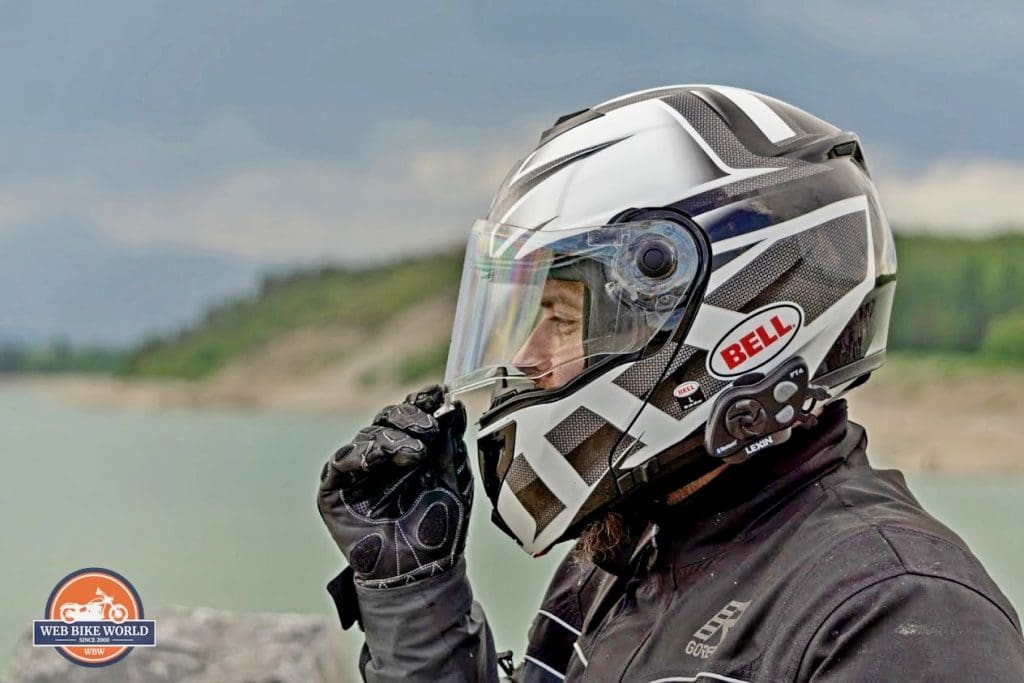
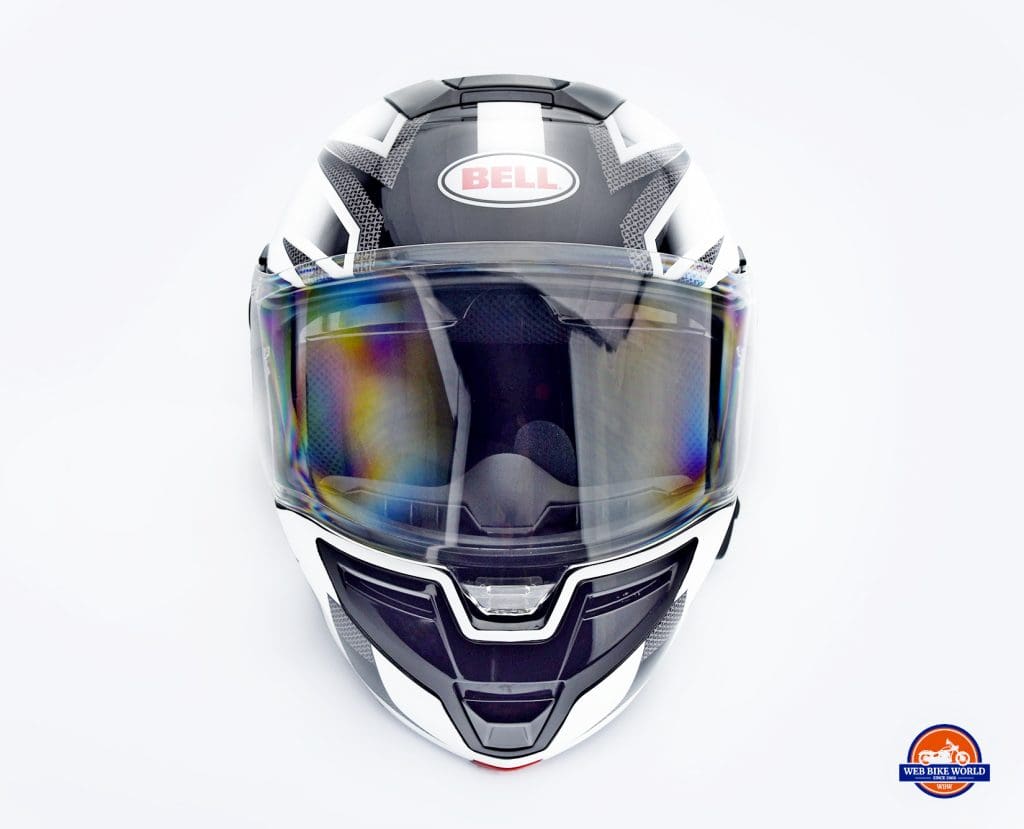
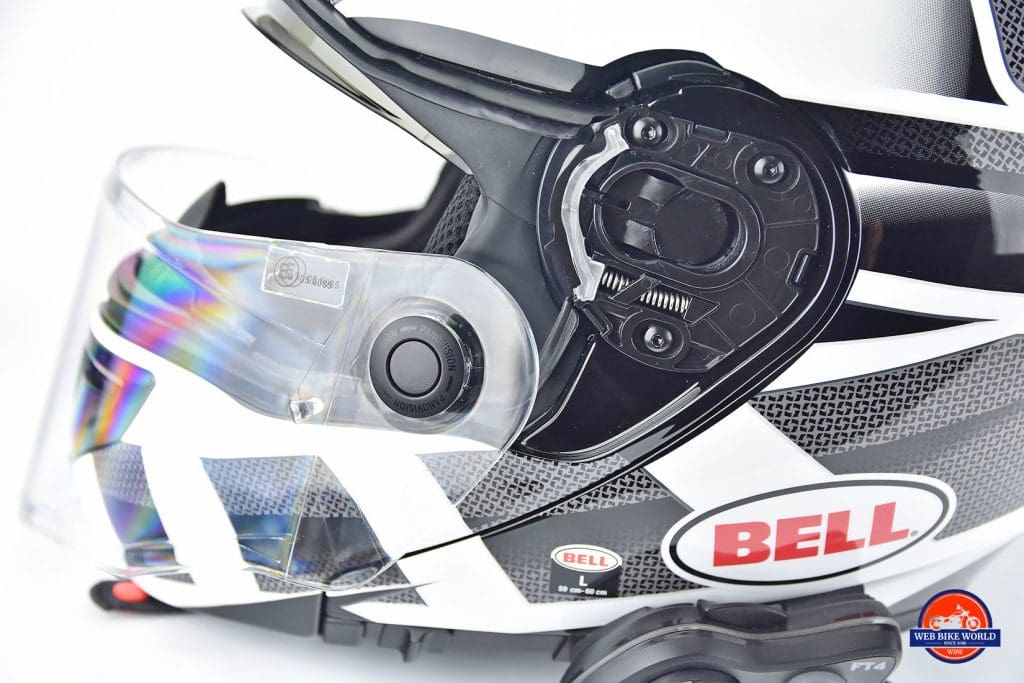
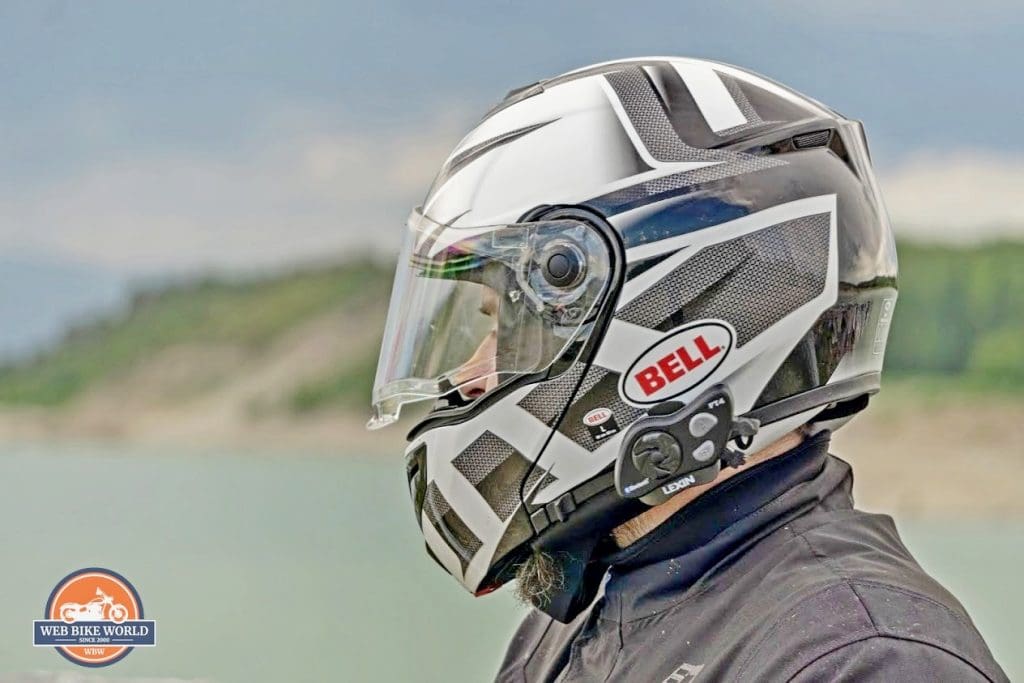
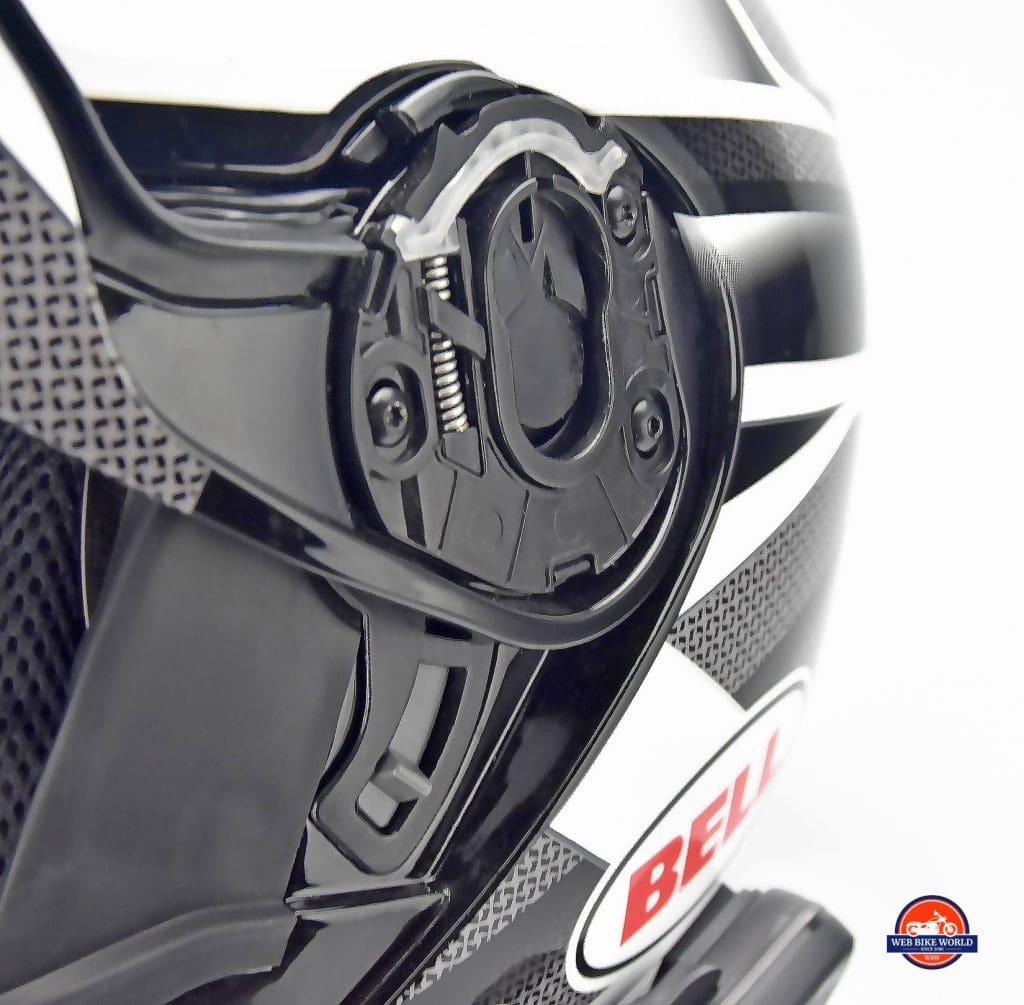
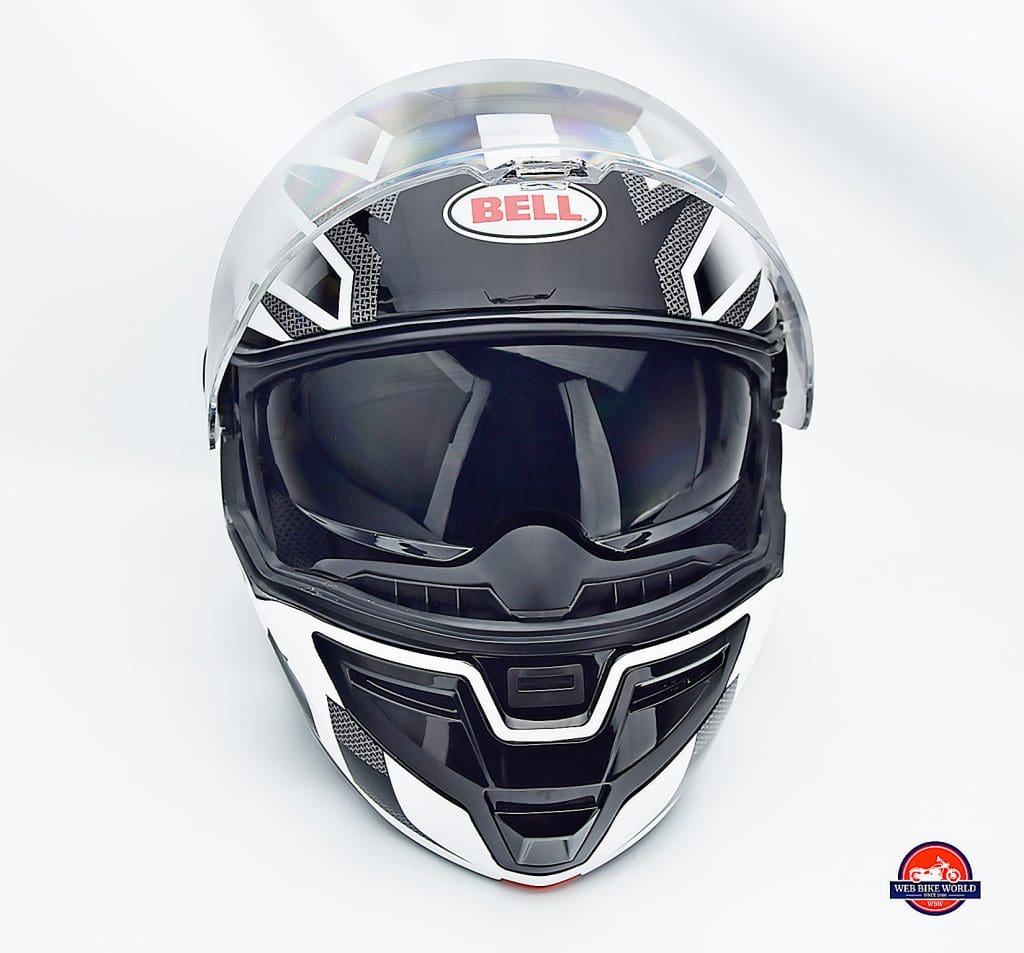
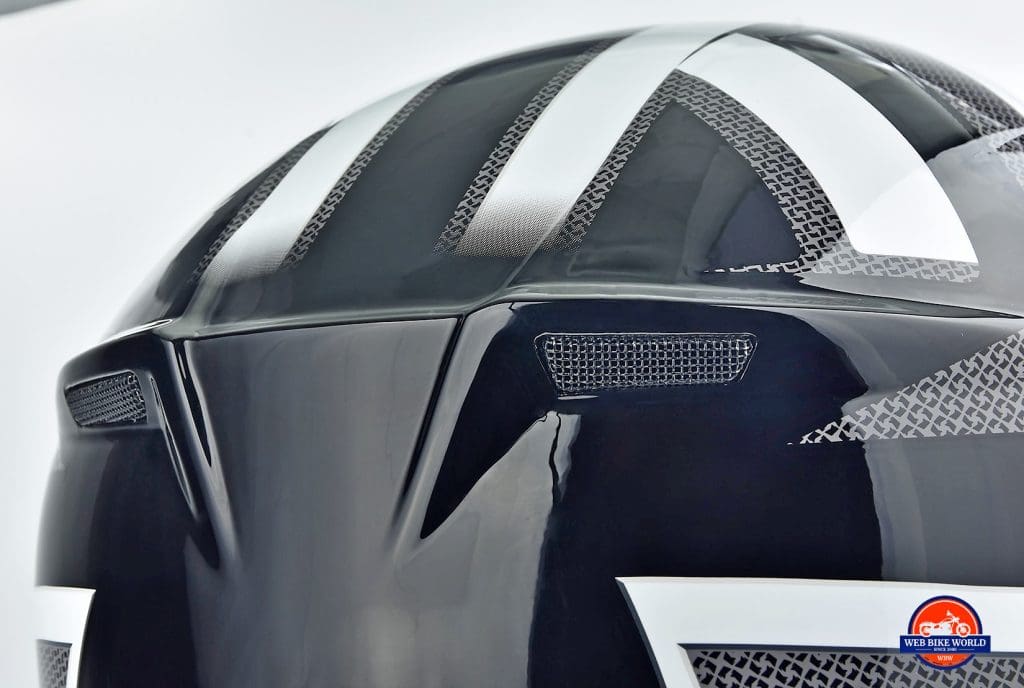
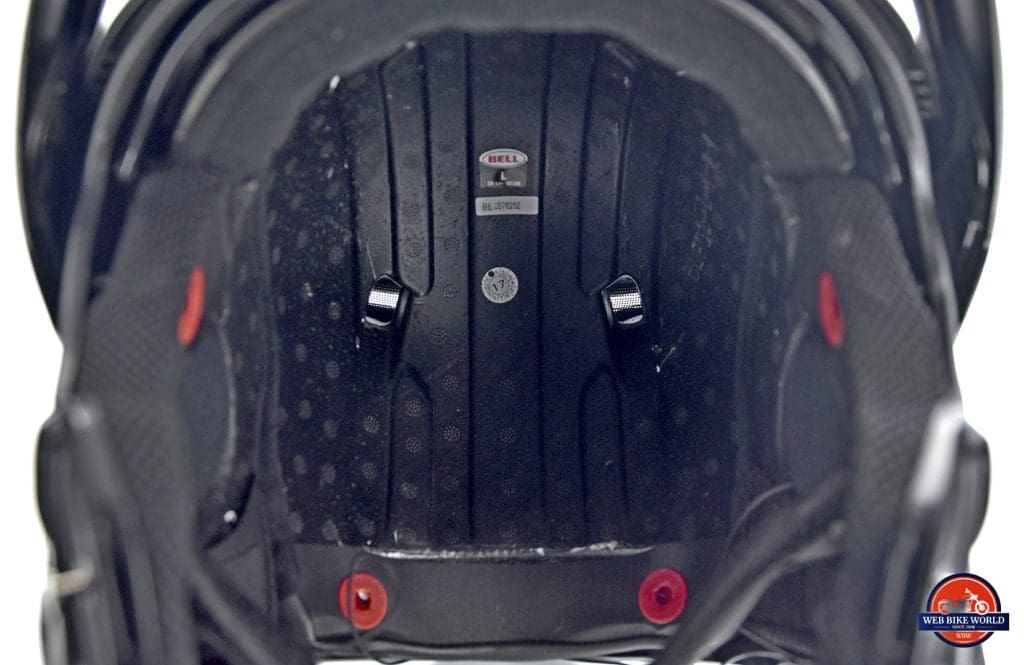
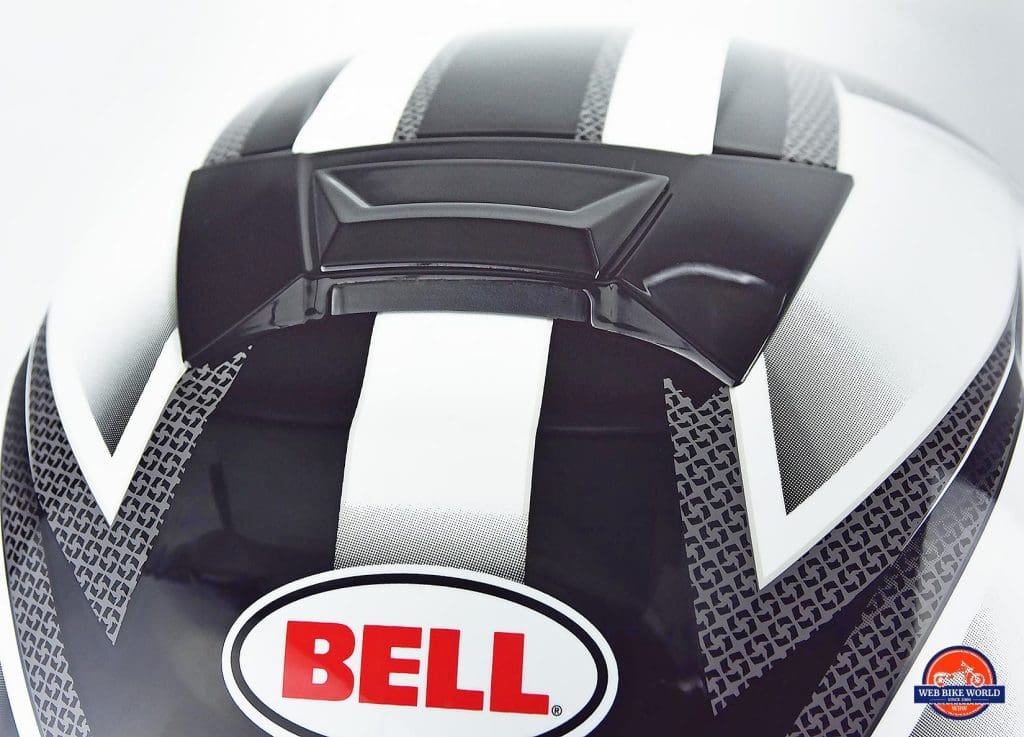
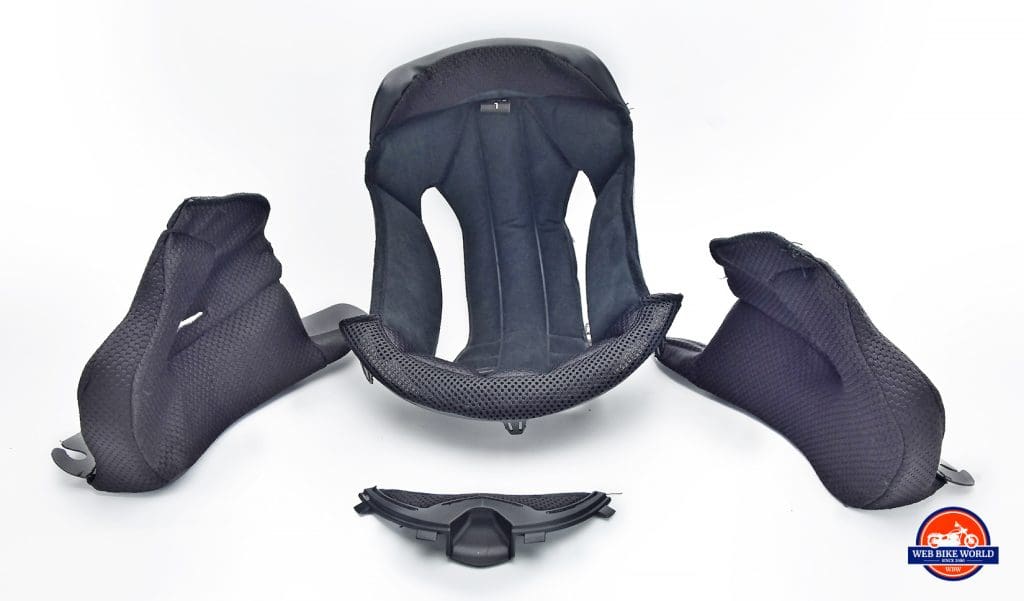
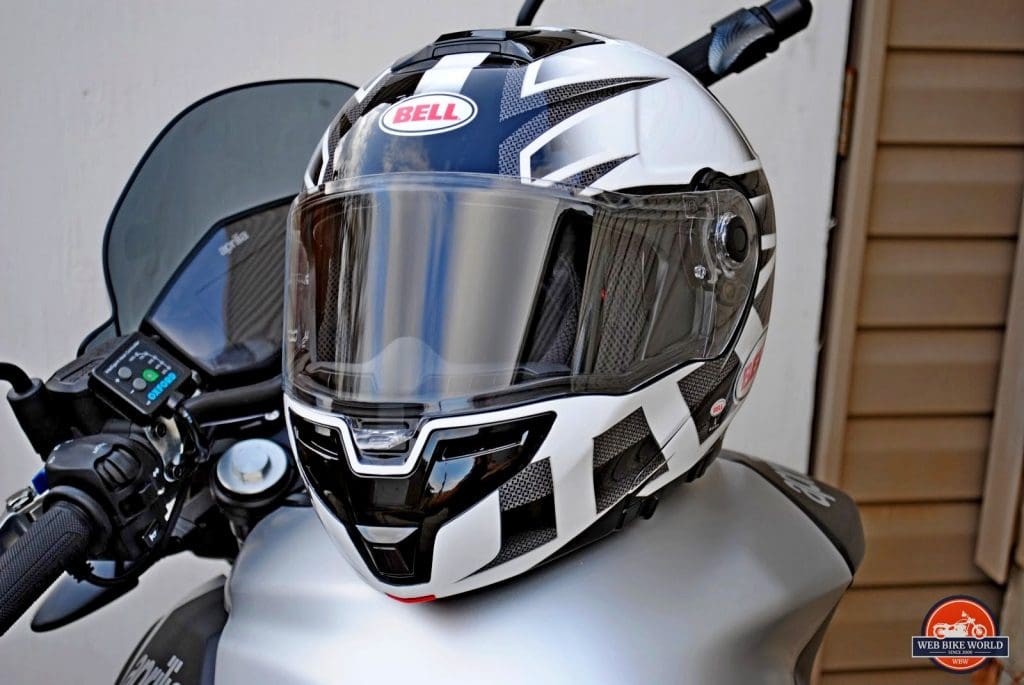
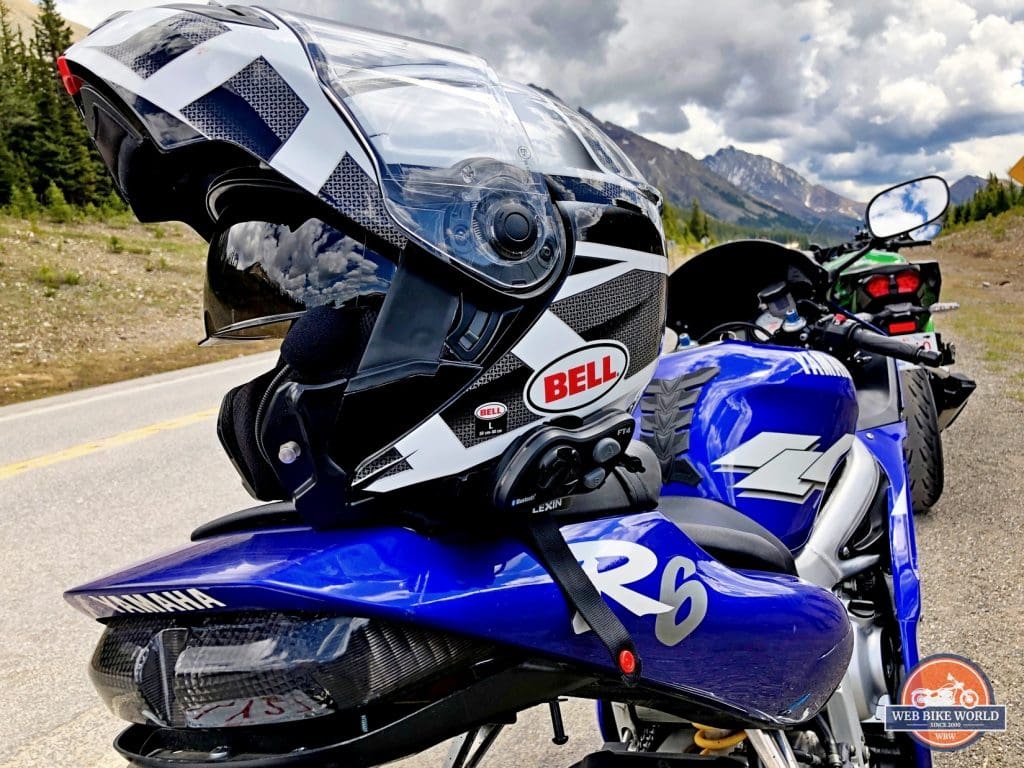
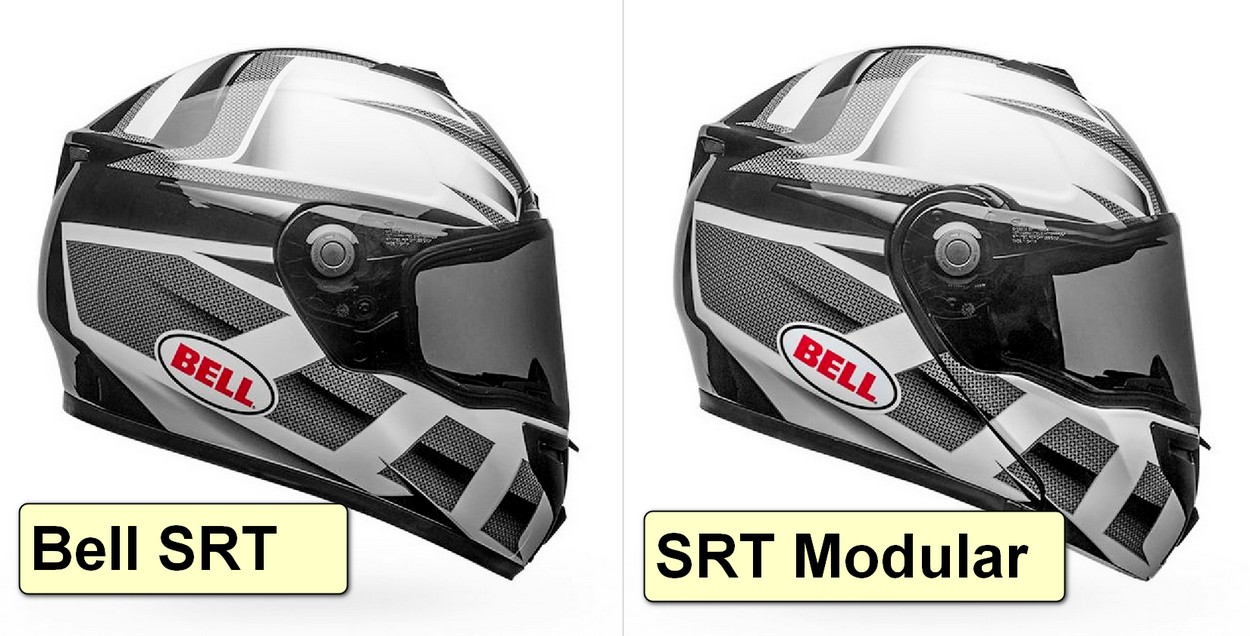
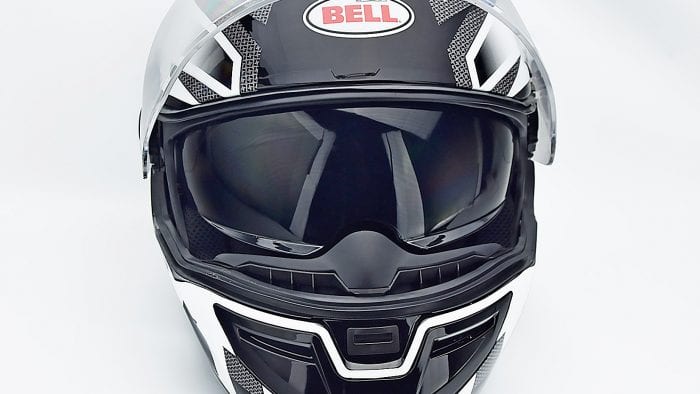
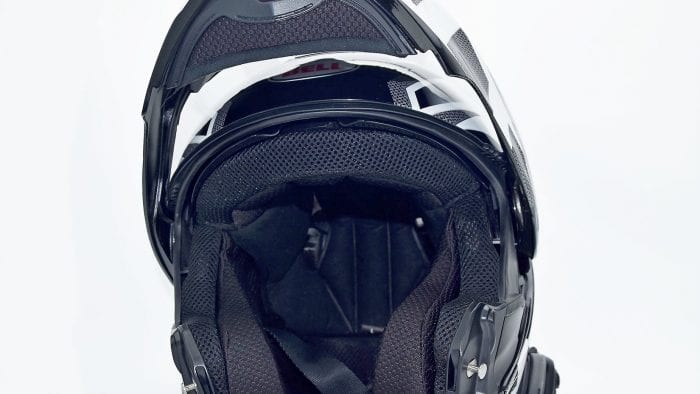

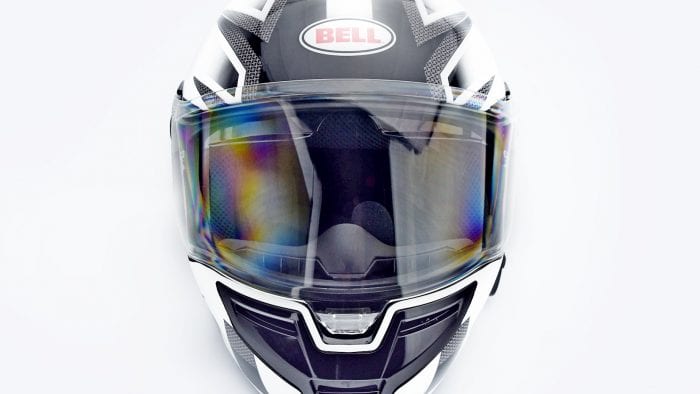
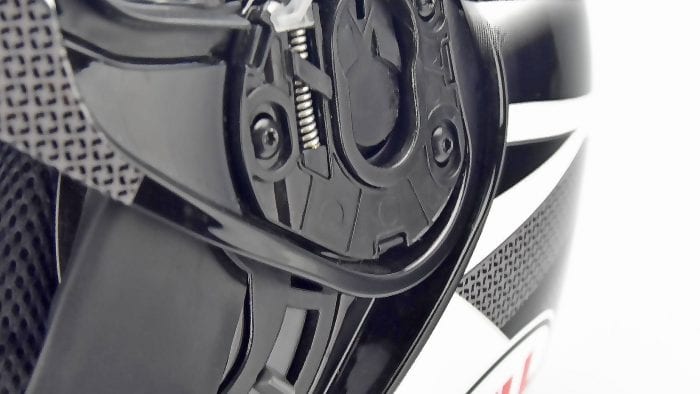
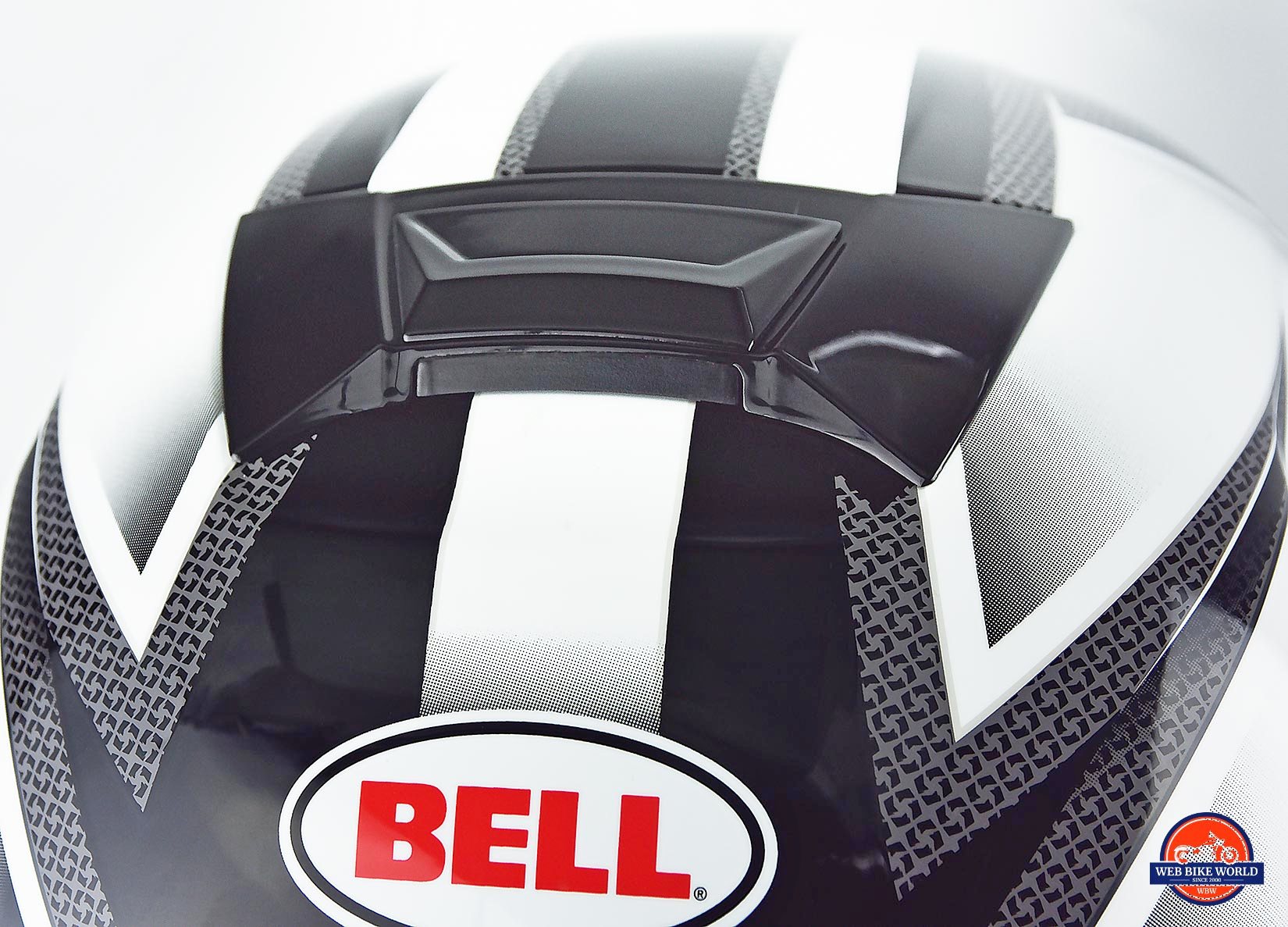
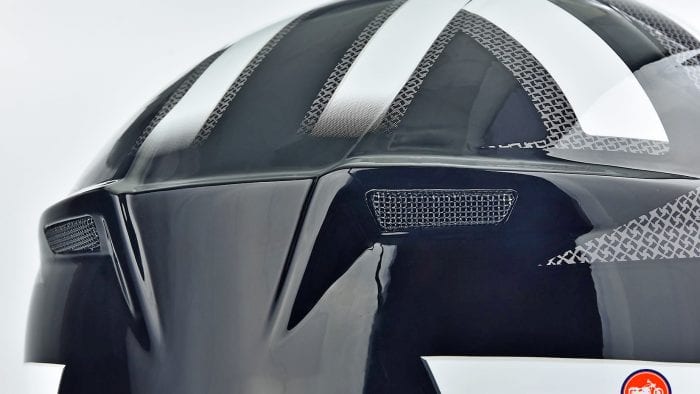
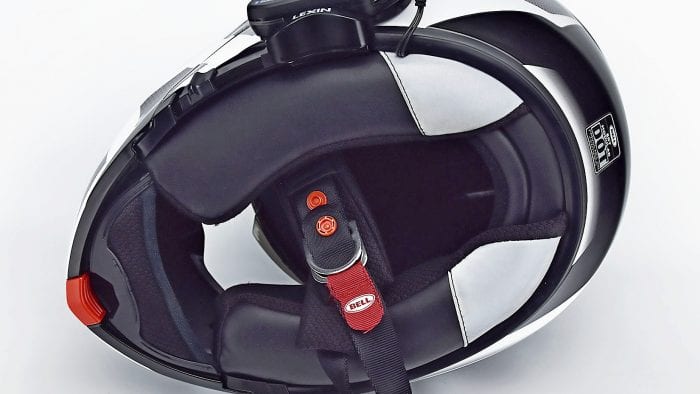

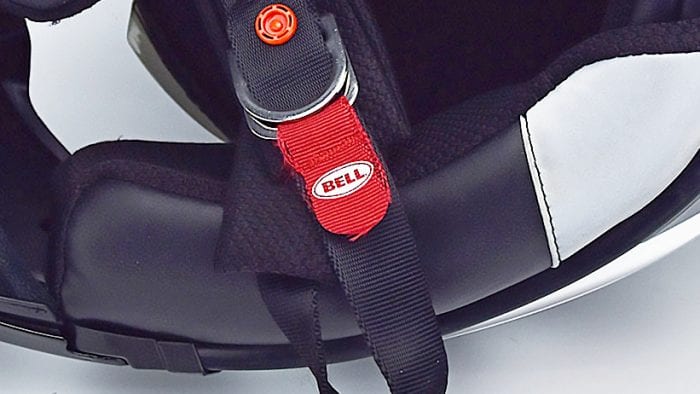
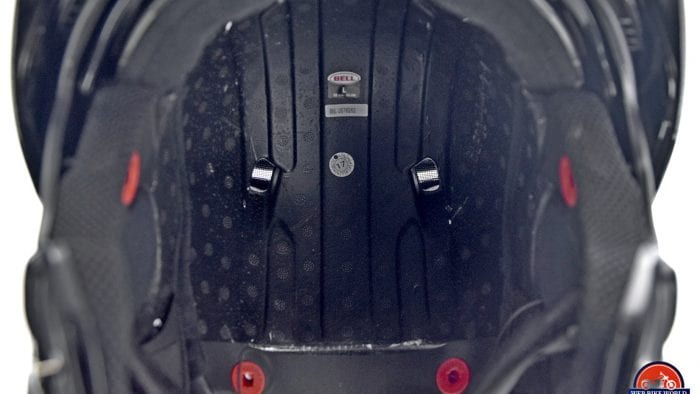
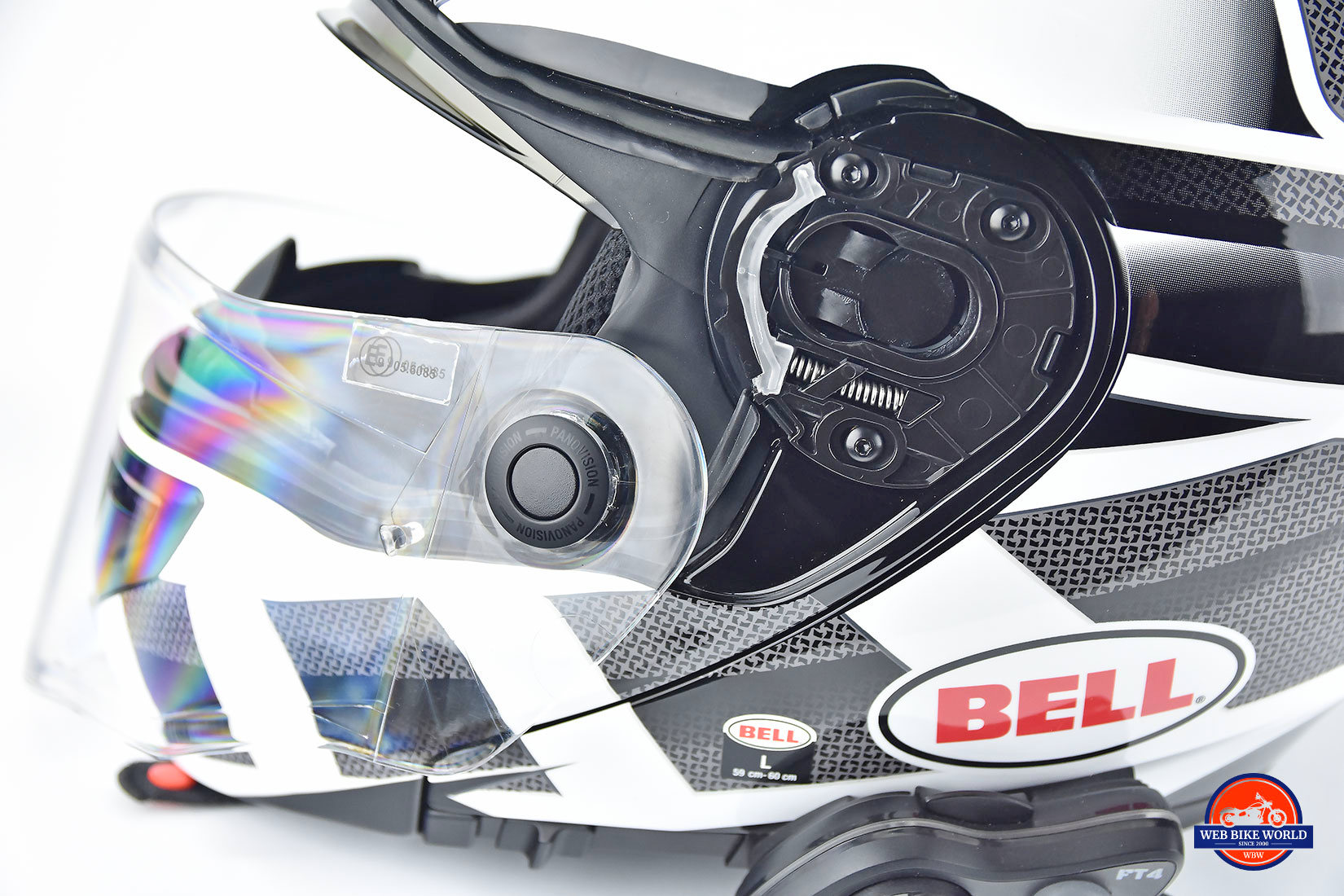

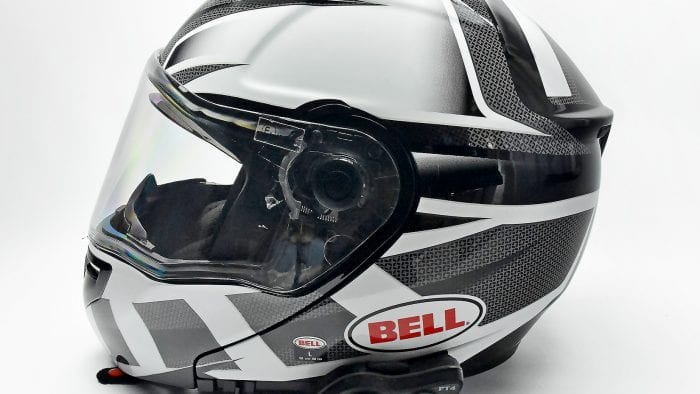
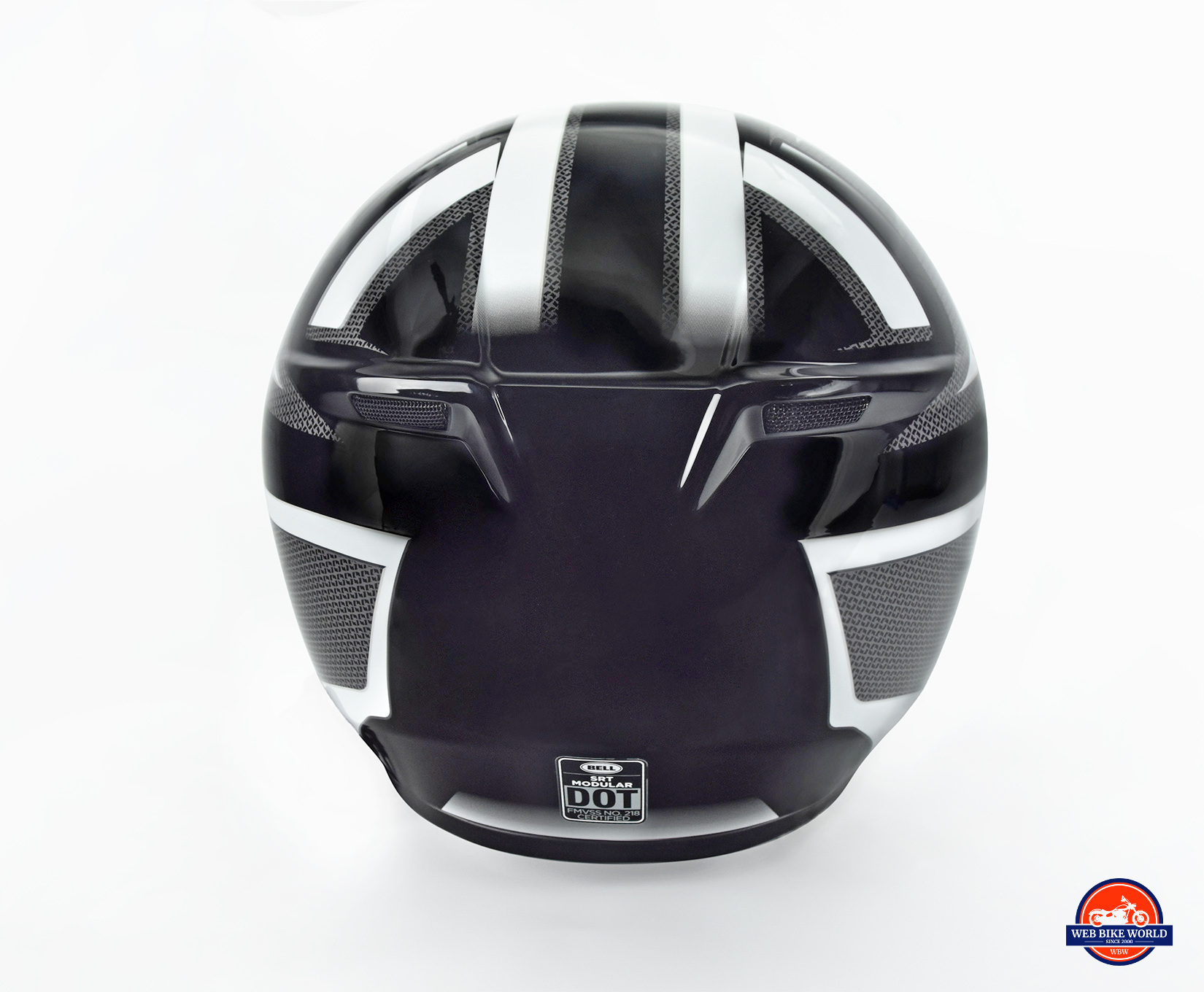






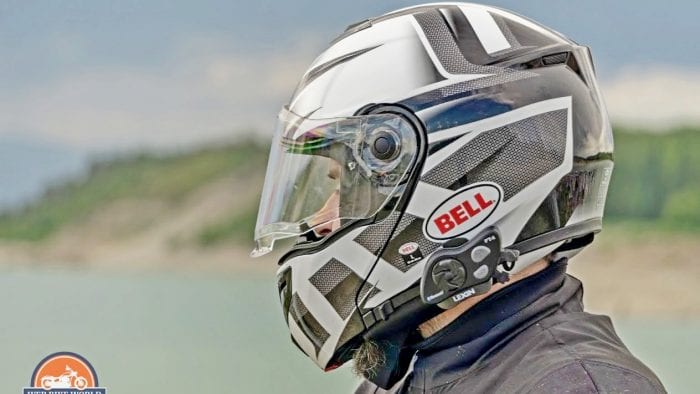


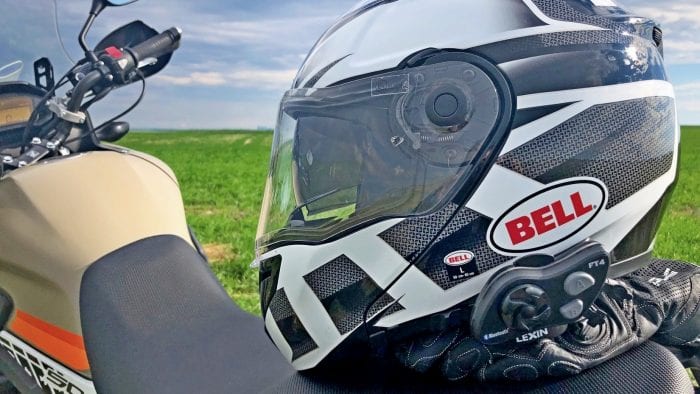
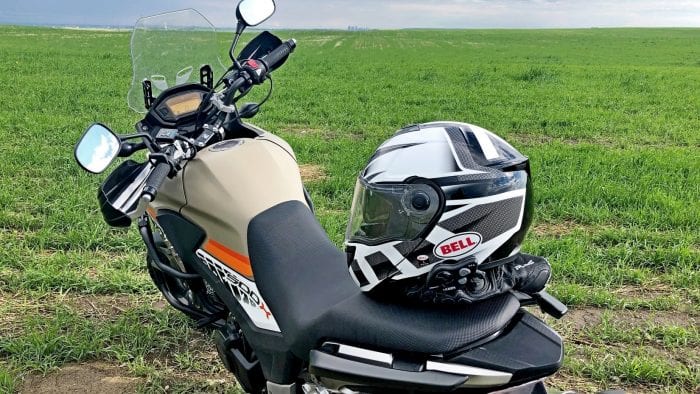
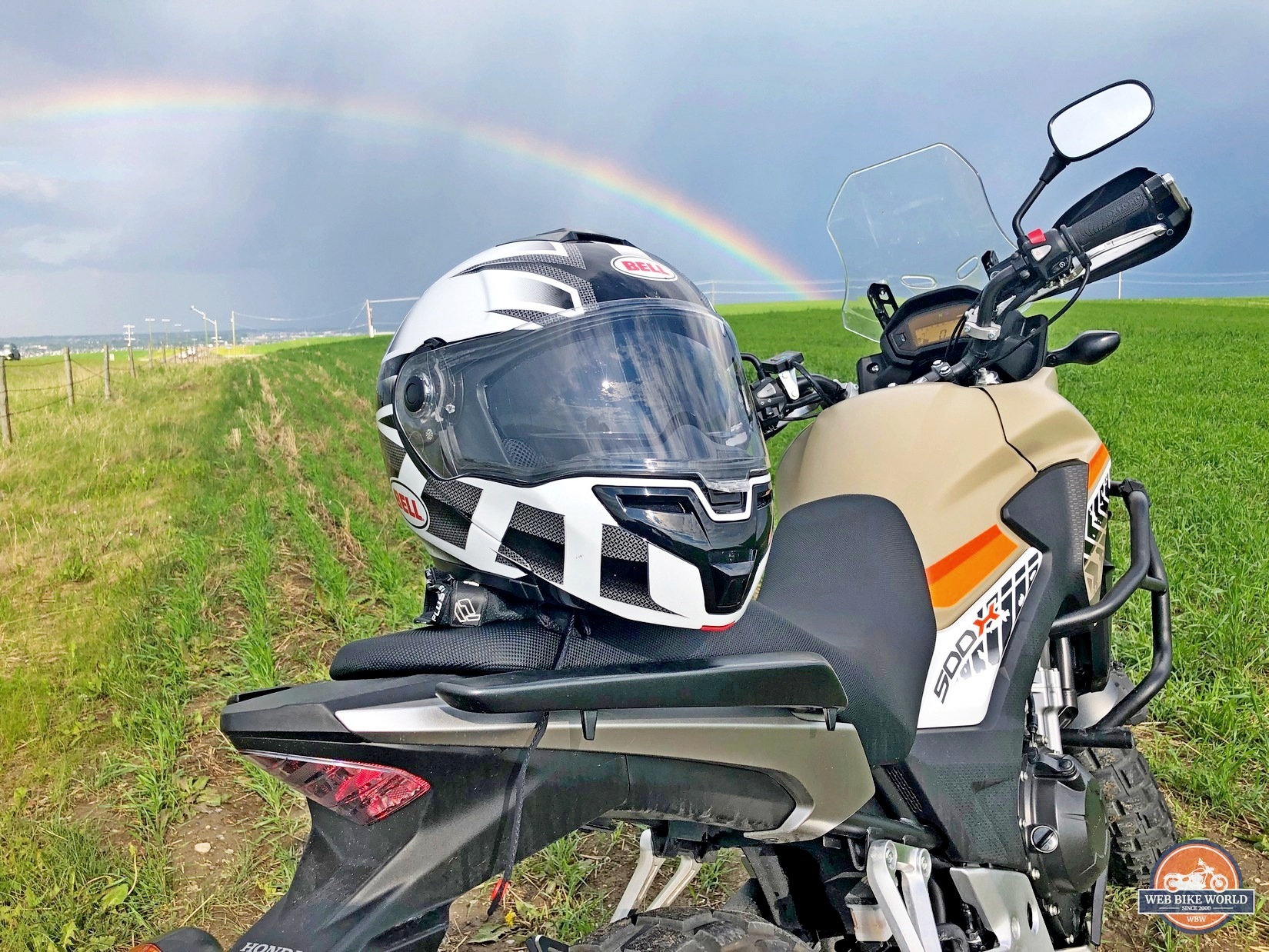
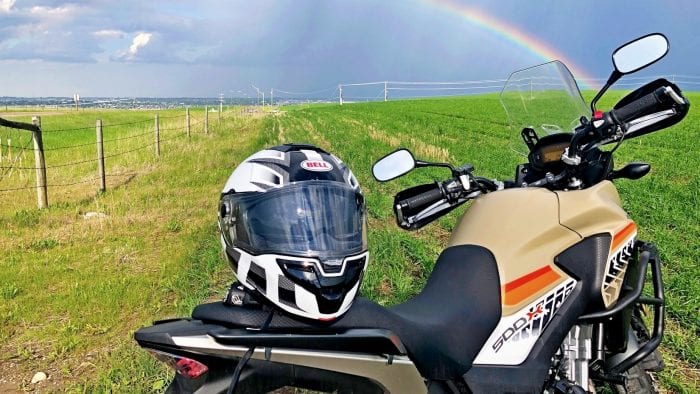
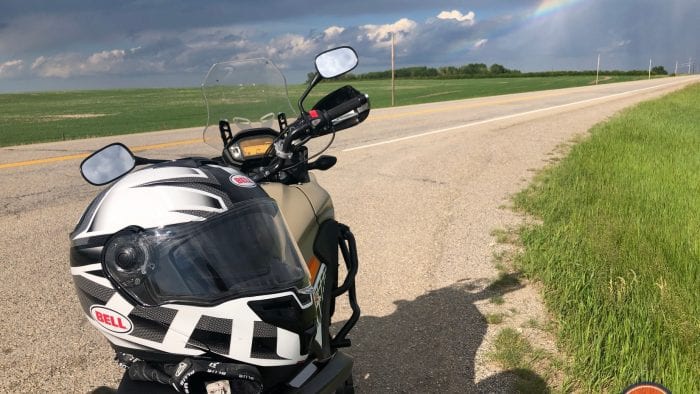
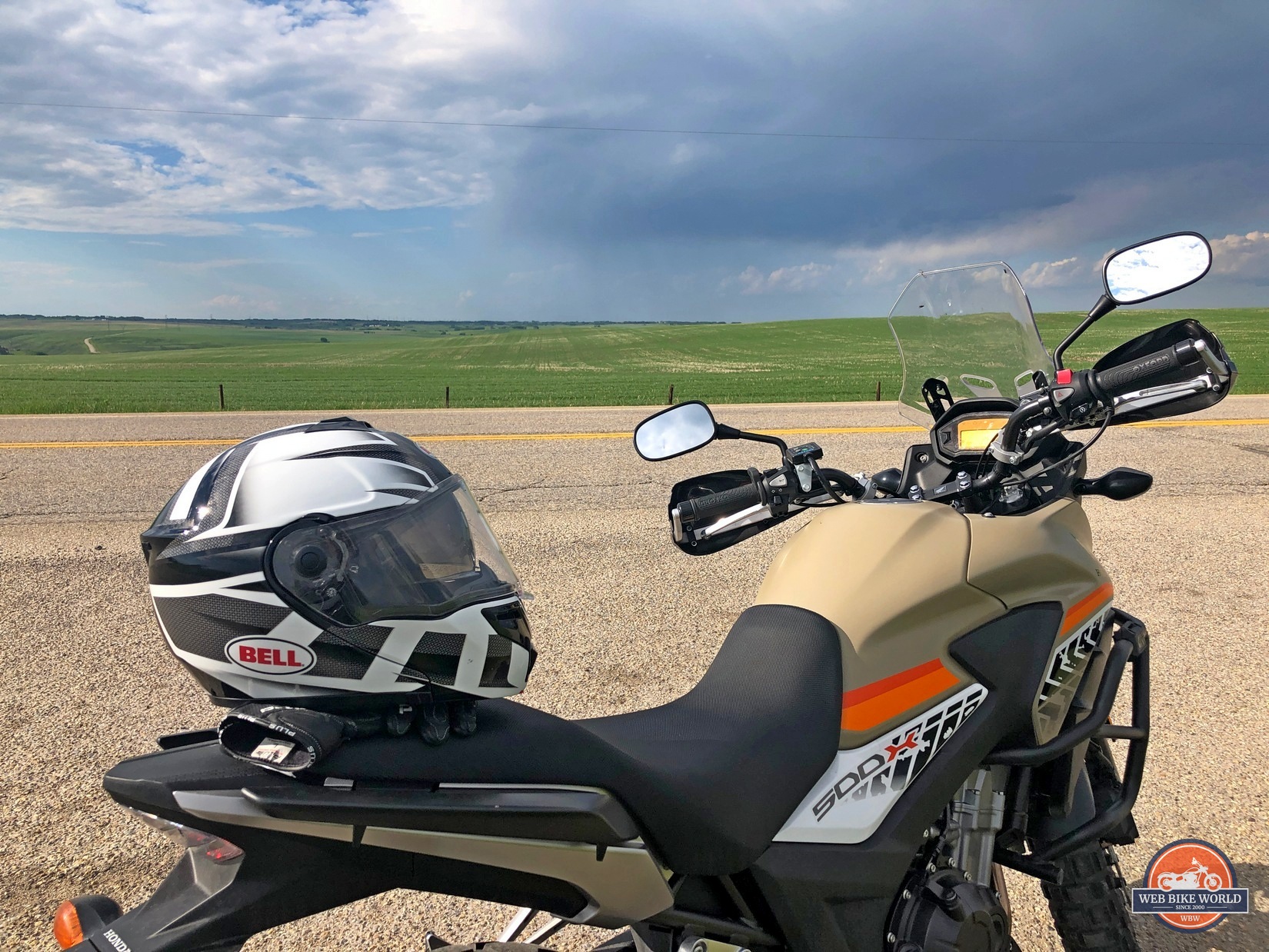

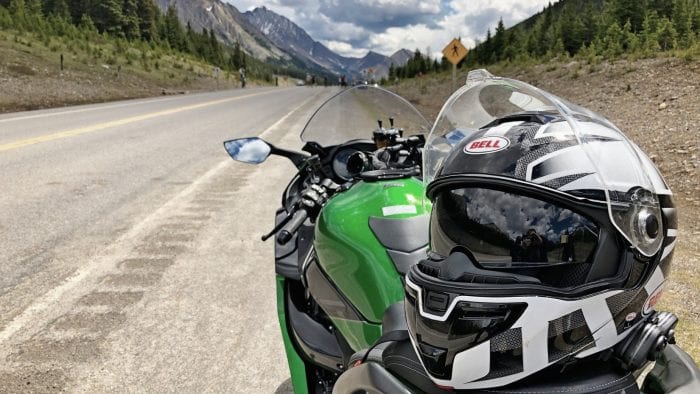

“Does adding an internal sun visor lens to the SRT Modular along with a hinged chin bar really disqualify it from receiving the SNELL M2015 safety rating given to the very similar SRT?”
Yes it does, but at least Bell and others give you the choice of flip up helmets and internal sun visors unlike Arai.
Hi Dan!
I think even Arai will give us a modular at some point. They are awesome quality helmets that will sell regardless, but at some point they have to give the people what they want.
Thanks for reading and commenting.
That’s the way I see it, let me make that decision. Arai’s external flip down sun visor doesn’t look good to me, and I think it would catch wind. Modular helmets with internal sun visors can meet the European ECE rating which I personally I think has every bit as much creditibilty as Snell, perhaps even more so.
From what I’ve seen ECE is excellent, but not quite as comprehensive as the Snell testing.
Still I like ECE certification on helmets because all helmet models with it have had at least one sample from the factory tested and pass the criteria as I understand it. DOT doesn’t but they do spot checks at random from what I know.
I have a friend with the Arai exterior sun visor and he says it works very well and doesn’t cause him grief, FWIW. I don’t have any personal experience with it though so I’m not sure. I’ve seen at least one of them in a store with broken tabs holding it on the helmet. It seems a little fragile.
Actually, Snell is ready to consider modular helmets, helmets with retractable tinted lenses and even helmets incorporating both these features. In the past, there have even been a few Snell certified modular helmets and at least one Snell certified model with a retractable sun visor. Here at Snell, we like the convenience of these features and won’t immediately turn away any helmet that comes with them. But we’re also not ready to give up any of the protective capability we demand in order to have these features.
Thanks for chiming in, Ed. I don’t ever want to see SNELL water down its expectations for sake of approval. I am glad that your standards are as high as they are.
Hi Ed!
I appreciate the feedback on this and didn’t realize you read our reviews.
Can you comment specifically on this Bell SRT vs SRT Modular case or send us testing results for the two helmets? I assume Snell has tested the modular and it didn’t pass?
I’d know there was the LS2 FF394 helmet once with the sun lens in it that passed Snell M2010 standards, but I haven’t seen any meet M2015 yet.
I completely agree with Cam about not wanting lesser standards from Snell, but is there a significant difference between these two helmets?
Jim,
Thanks for your message. Although I try to keep up with new helmet models, one of my colleagues saw your article and figured we should clarify our policy regarding modular and retractable visor models.
I cannot say much about test results. It’s safe to assume that if we certify a model, it has passed our certification tests and has continued to pass our enforcement testing afterwards. Our standard license agreement, the contract we have with each helmet maker in Snell programs, demands we keep confidential any proprietary information we might discern in our work here including test results and even whether the model was ever submitted for testing.
Generally, we don’t go out looking for new models to certify. Helmet makers decide whether they want Snell certification for a one of their models and, if they do, they submit that model for Snell testing. And if they do want Snell certification, they made that decision before they began design and development. The test performance we demand is well beyond what DOT is looking for; unless it is designed into the helmet, it just isn’t going to be there.
Having said all that, I’d be delighted to add a modular helmet and/or one with a retractable tinted lens to our lists. We’re in favor of any improvement which makes a helmet more convenient to use. We’re just not willing to give up any protection for it.
I appreciate the clarification Ed and I understand the need for discretion when it comes to helmet testing data.
I’m still struggling to work out why certain helmets are chosen to be tested to Snell levels and why others aren’t.
Obviously helmets used for racing should be checked to ensure the highest standards are met due to the obviously higher risk involved with race speeds.
Why do we get some $200 Scorpion helmets Snell certified while others costing 4 times that only get DOT? There’s no pattern I can pick out to be honest. There does seem to be an idea that building super lightweight helmets comes at a cost. Namely you can’t be lightweight and Snell certified.
It seems odd to me why every helmet isn’t built to the highest standard, but I suppose that’s the manufacturer’s call to make as you say, and you can’t explain their rationale for them.
At any rate your willingness to discuss any of this here is greatly appreciated and so is the testing Snell does in the name of saving lives. We here at wbw value Snell certification, so keep doing what you’re doing Ed.
Maybe one last question if you don’t mind: Which helmet do you personally choose to wear?
As I understand it, ECE is accepted by all major racing organizations, which makes it good enough for me. Here are some issues I’ve had with Snell. Open face helmets can be Snell certified, but modulars can’t, that makes no sense, to me anyway, I know their testing has changed, and I’m not certain how, but the blunt force testing with an anvil to a small area they used to do was criticized for not being representative of the larger area impact that would generally happen in a crash, and that this testing favored a hard helmet that might actually impart more force to your head. As Sharp ratings show, polycarbonate helmets, a soft helmet generally do very well in their tests, better than many of the fancy high dollar composite fiber helmets. The way I see it, I’ll accept a real DOT certification from any of the name brand helmet makers, and you pretty much have to if you wear a modular, as I trust they want to keep their customers alive, it’s essential for repeat business.
Dan it’s a real rabbit hole to go down when it comes to helmet testing standards as I’m beginning to discover lately.
Yes the poly helmets (in some cases) do well in crashes because they tend to need much thicker EPS liners to meet the DOT standards, but that also means they’re bigger and heavier too which could cause neck injuries instead of head injuries in a crash.
It’s interesting to see the thought behind the different testing criteria. ECE tends to favor lightweight helmets from what I can tell while DOT the opposite. Everyone is looking at things a different way when it comes to skinning the proverbial cat of head protection and I like aspects of all the different points of view. Ideally your helmet would change depending on the kind of crash it’s involved in to suit the circumstance but we know that’s impossible so what do you choose? Well for me I’d like to see as many certifications on the same helmet as possible. If I can get a DOT/ECE/Snell/BSA/FIM etc I’ll go for that one, but what would that lid look like and feel like I wonder? Snell recently came out basically condemning the new FIM criteria saying their efforts would actually cause more injuries believe it or not. Have a look here: https://www.roadracingworld.com/news/snell-foundation-says-new-fim-helmet-standards-increase-risk-of-head-injuries/
In fact, Ed Becker Snell’s Chief Engineer and Executive Director is commenting in this thread if you can believe it! I’m so thrilled to have him here answering some questions but I don’t want to pester him too much.
Here’s where it gets weirder with certification standards: I’ve noticed newer helmets from big brands like Shoei are starting to go back to being DOT only! The new GT Air 2 is an example of this. This is perplexing to me and seemingly the opposite of what good sense would demand, but their rationale is that the everyday rider doesn’t need helmets with that degree of protection. I’m convinced they must have solid data to back up that stance, but still it gives me a headache thinking about it.
So is DOT enough on its own? I guess so because as you say they’re looking for repeat customers and once word gets out things aren’t up to snuff that’s a huge blow for an established builder.
I’m happy to have SHARP around and hope they grow their very limited database soon. The more opinions involved the better for my head.
Almost every manufacturer, Shoei included, is putting internal drop down sun visors in their new helmets and no such helmets are Snell approved, as far as I know anyway. That’s why the DOT only ratings. Same for the hinge bar on modular helmets. It’s obvious that for many the convenience of these helmets are more important to them than a Snell rating.
Snell has approved at least one modular before at the M2010 level but I haven’t seen any at the new M2015 level. They’re open to doing it if the helmets will pass the test but it doesn’t seem like manufacturers are willing to build modulars that will pass the new Snell.
Jim, Thanks for the follow-up. Snell doesn’t really choose which helmets get tested. It’s the helmet makers who do the choosing. They choose which of their helmets they want tested. And they commit to abide by all the requirements of the Snell program: requirements like continuing to make the exact same helmet for sale to the public once it’s certified and also allowing us to purchase and test samples of this same helmet for standards enforcement afterwards.
As much as I’d like to run a survey of all the helmets currently available and test them all to Snell standards, I think we’d wind up passing just those helmets which are already in the Snell program. Snell levels of performance don’t happen by accident. Helmet makers opt for Snell early on, before the helmet gets onto the drawing board and maybe while it’s just a gleam in the marketing departments’ eye. Otherwise they shoot for DOT or ECE and wind up with a helmet that’s maybe a little lighter or sleeker but is certainly less capable than we’d ever consider these days.
I think that street riders need as much helmet as any competition rider. What with heavy vehicles, poorly maintained roads and distracted drivers, they’ve certainly got a lot more to worry about than anyone in a well regulated racing event.
Pricing may have little to do with protective capability. The EPS shock liners and fiberglass or composite shells that serve as impact protection in most helmets don’t cost all that much. The costs of Snell certification don’t amount to all that much either. I think much of the cost is for aspects not included in Snell testing, good ventilation, comfortable linings, multiple size configurations, etc. These things are important, particularly when you consider that riders will wear these helmets for hours at a time when all Snell worries about are the ten to twenty milliseconds that a crash impact might last. But, frankly, a rider will know better that we ever could whether a helmet is acceptable for routine riding. The most we can do is offer some advice for when a routine ride might turn into a catastrophe.
And now, a confession; I don’t ride. I was recruited for Snell because of my background in engineering, instrumentation and in research regarding human response to impact acceleration. My best advice is to look for a helmet you can stand to wear and stand to be seen wearing, otherwise you’re not likely to be wearing it when you need it most. Start looking at Snell certified full-face. If none of those will do, try Snell certified open face. If none of those will do then look for a DOT helmet from a reputable manufacturer. DOT is looking for about the same performance Snell was demanding back in 1968. A good DOT helmet might still save a rider and a rider’s family and friends a whole lot of grief.
It’s quite a lot to consider that’s for sure and I thank you for taking the time to try and explain it all here, Ed.
I’m just about to test my first Snell rated helmet for wbw believe it or not and of all the possible helmets it happens to be the Simpson Outlaw Bandit to my surprise. I’m looking forward to experiencing and noticing the differences you’ve pointed out. Will it have more noise or less ventilation than other non Snell certified helmets as you mention? I’ll find out. I’m glad you let me know that might be a possibility because when I test gear I often try to understand why a manufacturer built something the way they did. I’ve learned a lot from this exchange that will help me do better analysis I think. I wish I could walk through a helmet store and discuss helmets freely sometime, but again I understand you need to keep some details to yourself. I’m guessing you don’t offer tours to people like myself of the SMF? I’d be very interested in doing that if it is kosher.
Please feel free to comment anytime on our reviews if you can.
So you don’t ride a motorcycle at all? I think you’re really missing out Ed! hahaha
Dan, Thanks for your comment. I’m skeptical of ECE myself. The procedures specify only a few locations on the helmet shell for impact testing so, with some models, impact management evaporates for hits just a few centimeters away. DOT and Snell call for tests anywhere on or above a specified test line so it’s much harder to game the requirements. Of course, if your ECE helmet comes with DOT and from a reputable helmet maker, gaming the standard won’t be an issue. DOT is looking for slightly more impact management and not just in a few specific locations.
We would be delighted to test and certify modular helmets to Snell but we still want all the same performance we would demand of a full face helmet. We don’t turn away open face models because our interest here is brain protection. I recommend full face because that configuration has a better record of protecting the lower face and jaw. But riders can look at an open face helmet and know instantly just what they’re getting. If a rider doesn’t want full face, and more than a few don’t, they can still look for Snell levels of brain protection in a good open face helmet.
As for SHARP, it has the same problem I see in ECE; they test only a specific impact sites. It also troubles me that, like ECE, they seem to favor softer shells. The problem with softer shells is that impact with irregular, load concentrating surfaces like curbing can punch through working only a limited area of liner. Essentially, the shell bends around the curbing instead of spreading the load as it ought to. As a result, the impact liner exerts lower forces on the wearer’s head but the liner compression is necessarily much greater. And when the liner runs out of room to compress, the rest of the impact is transmitted straight to the wearer’s skull and brain. Unless you can choose your crash impacts, the best helmet is likely not to be the softest but, instead, the one that can see you safely through the most severe crash a current helmet might handle.
I thought DOT certification was self tested and certified by the helmet manufacturer. I don’t think any reputable helmet manufacturer wants to kill their buyers, so self certification doesn’t concern me as much as it might some. And concerning the ECE standard, as I stated it is accepted by all major racing organizations and 50 countries. If it was not a good standard I think the racing circuit would have exposed it by now. I’m a cautious 62 year old rider, anything approved for the racing circuit is more than good enough for me.
Gentlemen for those that say a racing helmet or its standard is good enough for you kind of makes me giggle a little. Why? Because the forces and angles I see in collisions for street riders varies wildly from the racers I pick up off our local tracks.
Basically on the track you got high sides and low sides. On basically the same style motorcycle. Enough to be in the same position when exiting the motorcycle.
Street riders way different animal. The bikes vary wildly. Front impacts on street riders is the most common. Hence the Goldwing with an airbag. These tend to have pelvic fractures when they fly forward and hips hit the bars breaking the pelvis. Don’t get me started about what windscreens do. Street riders tend to slide into fixed objects sometimes while rotating. There are no run offs on the street.
Street riding and closed course racing is not apples to apples comparison.
I’m also riding at way slower speeds than a racer. Helmets approved for racing are just ordinary full face helmets tested and certified by Snell, and ECE as are all certified helmets. They’re not tested differently, so as far as Snell and ECE is concerned, all the apples are the same.
To put it another way, DOT only helmets are street legal, even 1/2 lids, but they’re certainly not allowed on the racing circuit, so helmets approved for racing are indeed held to higher standards. Whether the street, or track is more dangerous doesn’t change that.
Speed is an issue mostly because things happen much more quickly making crashes maybe more likely. Unless you’re crashing into some sort of obstacle, though, the helmet really only has to manage the fall to the pavement. This can be pretty serious still but your helmet won’t have to manage your actual cruising speed, the velocity along the pavement. Instead, that cruising speed stays with you through that first smack into the roadway and gets scrubbed off as you slide along the surface afterwards. Still pretty serious but good leathers, boots and gloves may do for you along with the helmet as abrasion protection rather than impact management. Our most severe impact test is at a velocity a little over 17 mph. The fact that we do two impact may bump this up to as much as 22 mph but that’s about the limit. If you’re flying along at plus thirty mph and go head on into a bridge abutment, it’s likely to be game over for you no matter what your headgear.
There surely are differences in risk environments for racing and street riding but my best advice for either is all the impact management you can reasonably wear on your head. There are reasonably foreseeable crashes for which even the best possible won’t be enough but if you’re willing to take that chance, and many are, the best possible helmet is a reasonable way to go. For that reason, I urge Snell certified motorcycle helmets for racing and for street use. Even so, a good DOT helmet will also reduce some of the risk of head injury. I think you can do better but if you’re only willing to wear a good DOT helmet, then please wear it whenever you ride.
Shell size for a Med.is huge!.Its VERY heavy,VERY noisey to the fact that Comms are worthless at 60 mph an above…Bought this for my wife as an upgrade from the China job she was using……………..well she wants to keep the china job and toss the Bell….Wasted a lot of money for nothing,shame on you Bell for even releasing this thing to the market!!!!
Sorry to hear the SRT Modular didn’t work out for your wife’s needs, Garry. I honestly don’t find it that noisy or heavy compared to other helmets I’ve worn, but I agree it’s not quiet or lightweight. Is it too late to return it to the vendor and exchange it for something else?
OK Jim,
Based on your reviews and comments about the Nolan and the Bell I’ve ordered both. Nowadays finding a brick and mortar shop to try on lots of helmets is not easy. I did try on the Schuberth C4 Pro and hated the fit. The C3 Pro fit better, but I decided against the brand. Was shocked that the Shoei Neotec II fit so well since I’m more of an Arai head. But man the wait times to get one in the color and size I need is ridiculous right now. So once I get these and try them on I’ll decide. Thanks for these great reviews, helps a lot.
Hi Mark!
Of the two I would more happily wear the Nolan because it’s lighter, but the Bell isn’t a bad helmet itself. One of them will work for you I’m sure.